Best Blue Flowers
Some of the plants in this list may have a purple or other than blue hue in the flowers and may not be ‘pure blue’.
1. Jacquemontia
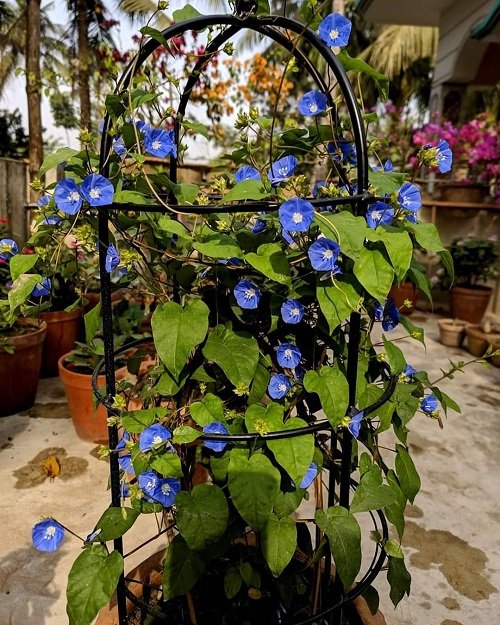
Botanical Name: Jacquemontia pentanthos
- Type: Perennial vine
- Origin: Native to the Americas
- Size: Varies depending on the species
- Light Requirements: Full sun to partial shade
- USDA Hardiness Zones: 8-11
With delicate, sky-blue petals that dance in the breeze, Jacquemontia adds a touch of serenity to any garden. These blue flowers are small but captivating, making them a sweet addition to your outdoor sanctuary.
Growing Tip: Jacquemontia, also known as Sky Blue Clustervine, thrives in full sunlight. Ensure well-draining soil and allow the soil to dry out between watering to prevent root rot. It’s a climbing plant, so provide a trellis or support for it to climb. Prune it occasionally to maintain its shape and encourage more blooms.
2. Yesterday, Today, and Tomorrow
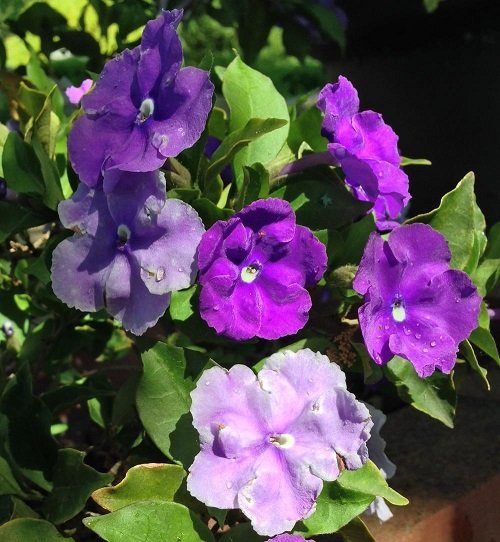
Botanical Name: Brunfelsia pauciflora
- Type: Shrub
- Origin: Brazil
- Size: Up to 8 feet tall
- Light Requirements: Full sun to partial shade
- USDA Hardiness Zones: 7-10
The enchanting name of these flowers reflects their remarkable color-changing nature. As they bloom, you’ll witness a captivating transformation from deep purple “Yesterday” to pale lavender “Today” and finally, pristine white “Tomorrow.”
Growing Tip: This unique flower requires partial shade for optimal growth. Keep the soil consistently moist but not waterlogged. Pruning is essential after flowering to encourage new growth and maintain its compact shape. Be patient as the flowers change colors from purple to lavender to white over a few days.
3. Agapanthus

Botanical Name: Agapanthus africanus
- Type: Herbaceous perennial
- Origin: South Africa
- Size: 1 to 3 feet tall, depending on the variety
- Light Requirements: Full sun to light shade
- USDA Hardiness Zones: 8-11
Native to South Africa, Agapanthus is celebrated for its stunning globe-like clusters of blue flowers. These elegant blooms gracefully sway in the wind, making them a favorite among garden enthusiasts.
Growing Tip: Agapanthus, or Lily of the Nile, prefers well-draining soil and should be planted in a sunny to partly shaded location. Water deeply but infrequently to promote deep root growth. Divide the clumps every few years to rejuvenate the plant and increase its blooms.
4. Aster

Botanical Name: Aster amellus
- Type: Herbaceous perennial
- Origin: North America and Eurasia
- Size: Varies depending on the species
- Light Requirements: Full sun to light shade
- USDA Hardiness Zones: 3-9
Asters come in various shades, including the soothing purple and light blue flowers that bring a touch of tranquility to your garden. These daisy-like blossoms are a late-summer delight.
Growing Tip: Asters are sun-loving flowers that need well-drained soil. Deadhead spent blooms to encourage continuous flowering. To prevent powdery mildew, ensure good air circulation and avoid overhead watering. A layer of mulch can help retain soil moisture.
5. Beth’s Blue
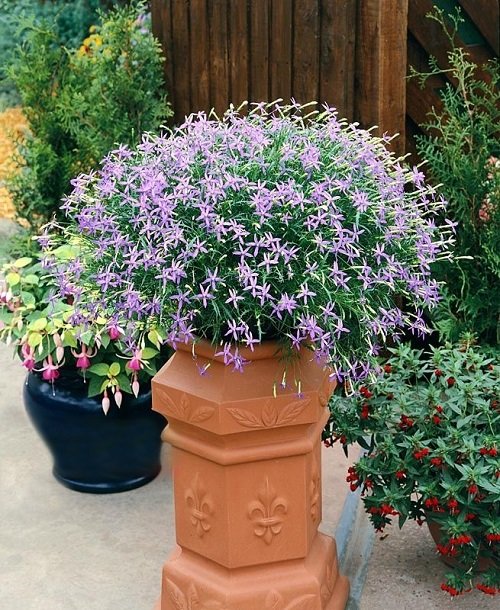
Botanical Name: Isotoma axillaris
- Type: Perennial ground cover
- Origin: Australia
- Size: Up to 6 inches tall and 2 feet wide
- Light Requirements: Full sun to light shade
- USDA Hardiness Zones: 8-10
Beth’s Blue blankets the ground with tiny, star-shaped blossoms. Its enchanting flowers create a heavenly carpet underfoot, making it a delightful ground cover.
Growing Tip: Beth’s Blue, or Rock Isotome, prefers full sun to light shade. It thrives in well-drained soil and should be watered regularly but not excessively. Deadheading spent flowers will prolong the blooming period. Consider growing it in containers or hanging baskets for a charming trailing effect.
6. Birdbill Dayflower
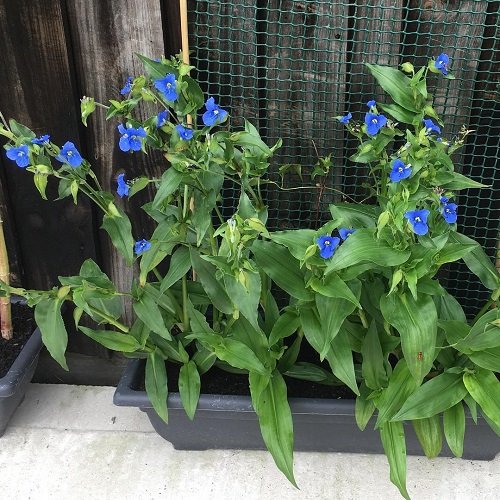
Botanical Name: Commelina dianthifolia
- Type: Herbaceous perennial
- Origin: North America
- Size: Up to 2 feet tall
- Light Requirements: Full sun to light shade
- USDA Hardiness Zones: 6-9
Bird’s bill dayflower is a member of the spiderwort family and is known for its attractive blue bonnet flowers.
Growing Tip: Birdbill Dayflowers like full sun to partial shade and well-draining soil. These unique flowers are known for their vibrant blue petals. Keep the soil consistently moist, but avoid waterlogging. Pruning the plant’s straggly growth will keep it looking tidy and encourage new blooms.
7. Blue Orchid
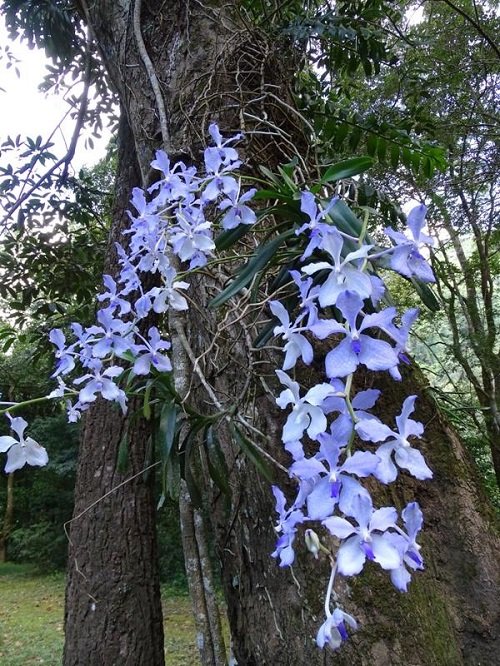
Botanical Name: Vanda coerulea
- Type: Orchid (usually hybrid or dyed)
- Origin: Various tropical regions
- Size: Varies depending on the species
- Light Requirements: Bright, indirect light
- USDA Hardiness Zones: 9-11 (for some orchid species)
Renowned for its exquisite, rare blue orchid flowers, this one is the epitome of elegance. Native to Thailand and Myanmar, these orchids are a symbol of luxury and beauty.
Growing Tip: Blue Orchids are stunning but require specific care. Provide bright, indirect light and maintain a consistent humidity level. Water them sparingly, allowing the roots to dry between watering. Fertilize lightly to support healthy growth, and repot when the orchid outgrows its container.
8. Butterfly Pea
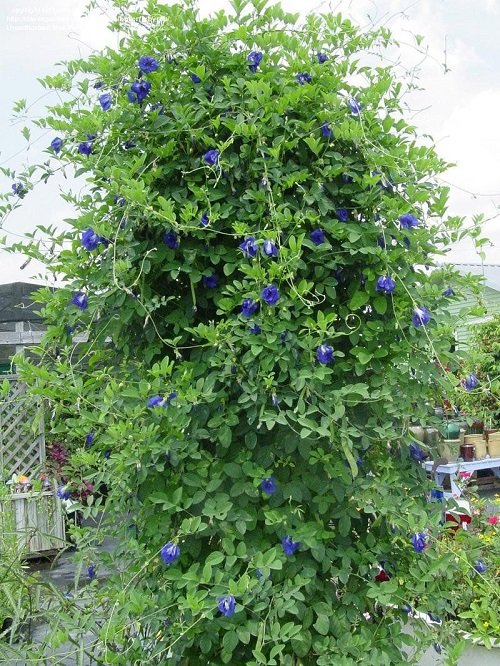
Botanical Name: Clitoria ternatea
- Type: Perennial vine
- Origin: Southeast Asia
- Size: Up to 10 feet long
- Light Requirements: Full sun
- USDA Hardiness Zones: 10-11
With striking indigo petals, Butterfly Pea earns its name as it’s frequented by graceful pollinators. These mesmerizing blue flowering plants are used in many ways.
Growing Tip: Butterfly Pea plants need full sunlight to thrive. They prefer well-drained, slightly acidic soil. To enhance the blue flower color, maintain a slightly acidic soil pH. Regularly deadhead faded blooms to encourage continuous flowering, and consider using the flowers to make blue herbal tea.
9. Bellflower

Botanical Name: Campanula spp.
- Type: Annual or hardy perennial
- Origin: Europe, Asia, and North America
- Size: Varies depending on the species
- Light Requirements: Full sun to partial shade
- USDA Hardiness Zones: 3-11 (varies by species)
Blue bell flowers are annuals or hardy perennials and can survive winter temperatures in most regions. You can simply propagate these through division, stem cuttings, or seed.
Growing Tip: Bellflowers come in various species, but most prefer full sun to partial shade. Ensure well-drained soil and water consistently to keep the soil evenly moist. Deadheading spent flowers can extend the blooming period. Some varieties may benefit from staking to keep the tall stems upright.
10. Blue Columbine
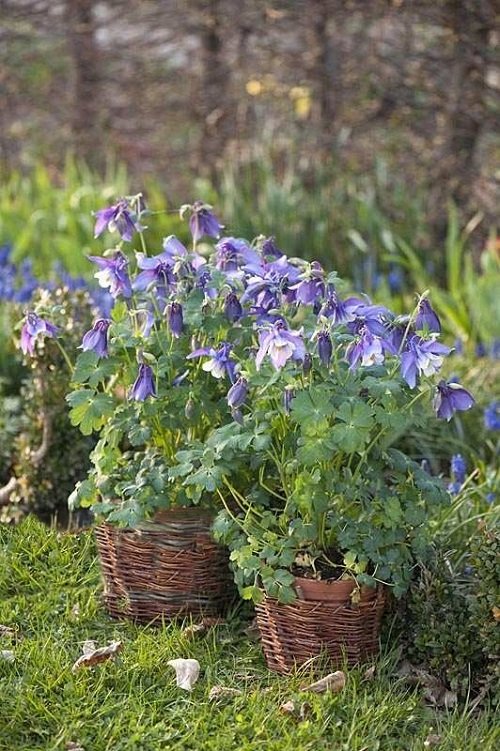
Botanical Name: Aquilegia caerulea
- Type: Herbaceous perennial
- Origin: North America
- Size: Up to 2 feet tall
- Light Requirements: Full sun to light shade
- USDA Hardiness Zones: 3-8
Colorado’s state flower, Blue Columbine, exhibits a captivating blend of blue and white flowers. These wildflowers grace the Rocky Mountains with their ethereal charm.
Growing Tip: Blue Columbines are easy to grow in well-draining soil and partial shade. These charming flowers attract pollinators. Deadheading spent blooms encourage reflowering and prevent self-seeding. Mulch around the plants to conserve soil moisture and maintain a cool root zone.
11. Blue Iris Flowers
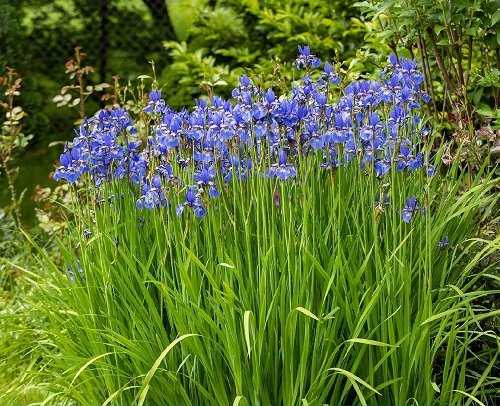
Botanical Name: Iris versicolor
- Type: Herbaceous perennial
- Origin: North America
- Size: Up to 3 feet tall
- Light Requirements: Full sun to partial shade
- USDA Hardiness Zones: 2-7
With their striking royal blue hue, Blue Iris Flowers are like nature’s masterpiece. These elegant blooms are known for their symbolic meaning of wisdom and courage.
Growing Tip: Blue Iris Flowers, also known as Northern Blue Flag, thrive in wet or marshy areas. Plant them near ponds or in well-moistened soil. Provide full to partial sun for the best blooms. Be sure to divide and replant clumps every few years to maintain their vigor and vibrancy.
12. Blue Ginger
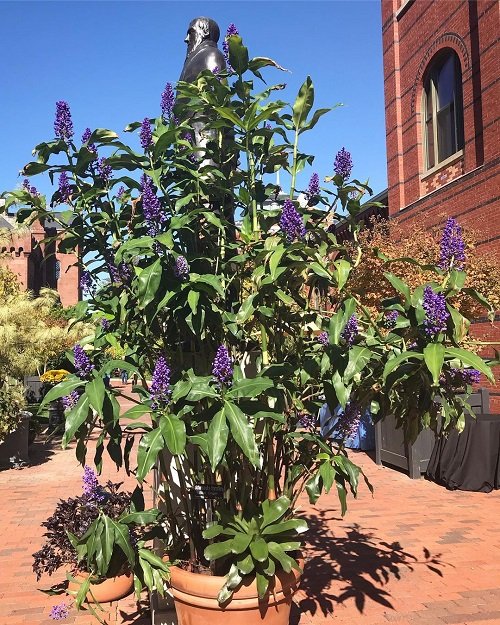
Botanical Name: Dichorisandra thyrsiflora
- Type: Tropical perennial
- Origin: Southeast Asia
- Size: Up to 6 feet tall
- Light Requirements: Full sun to light shade
- USDA Hardiness Zones: 10-12
Their captivating hues evoke a sense of calmness and tranquility, making them perfect for meditation spaces or serene landscapes. These blue bonnet flowers are sure to delight any observer.
Growing Tip: Blue Ginger is a tropical beauty that prefers bright, indirect light and well-draining soil. Keep the soil evenly moist but avoid overwatering. This unique plant appreciates high humidity, so misting the leaves occasionally can promote healthy growth and stunning blue-purple flowers.
13. Balloon Flower
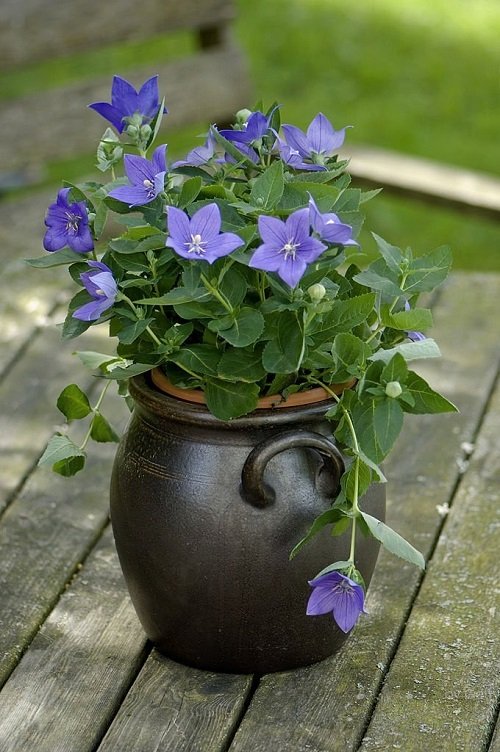
Botanical Name: Platycodon grandiflorus
- Type: Herbaceous perennial
- Origin: East Asia
- Size: Up to 2 feet tall
- Light Requirements: Full sun to light shade
- USDA Hardiness Zones: 3-8
These whimsical Balloon Flowers seem to be sending blue signals to the sky. Their round, inflated buds burst into delightful blossoms that resemble a cluster of small balloons, creating a playful and cheerful atmosphere.
Growing Tip: Balloon Flowers are named for their distinctive balloon-like buds that burst open to reveal charming blue blooms. Plant them in well-drained soil and provide full sun to partial shade. Deadhead spent blossoms to encourage continuous flowering, and they’ll reward you with their delightful presence.
14. Blue-Eyed Grass
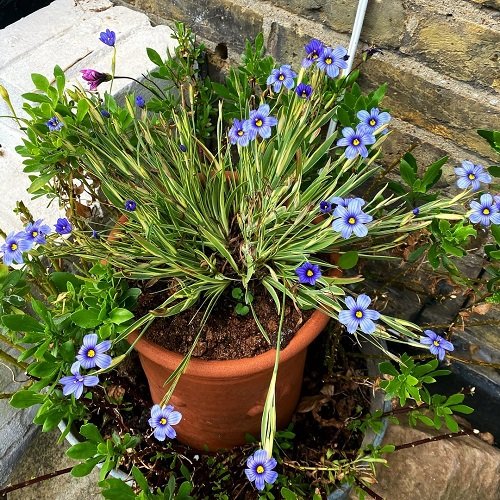
Botanical Name: Sisyrinchium angustifolium
- Type: Herbaceous perennial
- Origin: North America
- Size: Up to 1 foot tall
- Light Requirements: Full sun to light shade
- USDA Hardiness Zones: 4-11
Blue-Eyed Grass, despite its misleading name, offers petite yet enchanting deep blue blooms. These tiny wonders add a touch of elegance to your garden, like a sprinkle of stardust on the earth. They are truly one of nature’s wonders among blue flowers names.
Growing Tip: Blue-Eyed Grass, a charming native plant, prefers full sun to light shade. Plant it in well-draining soil and water moderately. This unique flower’s name comes from the striking blue centers of its petite, iris-like flowers. Allow it to naturalize in your garden for a touch of wild beauty.
15. Blue Primrose
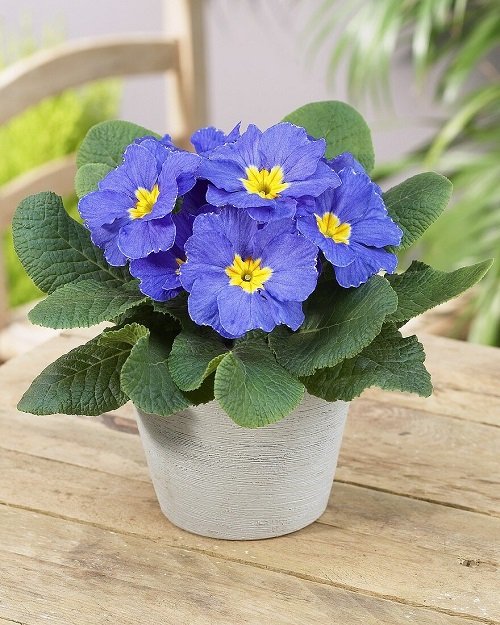
Botanical Name: Primula acaulis
- Type: Herbaceous perennial
- Origin: Europe
- Size: Up to 6 inches tall
- Light Requirements: Full sun to partial shade
- USDA Hardiness Zones: 4-7
The Blue Primrose, with its delicate petals and sky-blue color, is the epitome of grace. These charming flowers grace your garden with their presence, bringing a sense of serenity to your outdoor space. Blue Primroses are like the embodiment of serenity among light blue flowers.
Growing Tip: Blue Primroses are cold-hardy plants that thrive in partial shade and well-draining soil. Keep the soil moist but ensure it is not waterlogged. These dainty flowers provide early spring color to your garden and can be grown in pots or as ground cover. Divide and replant them after flowering to maintain their health and vigor.
16. Blueblush
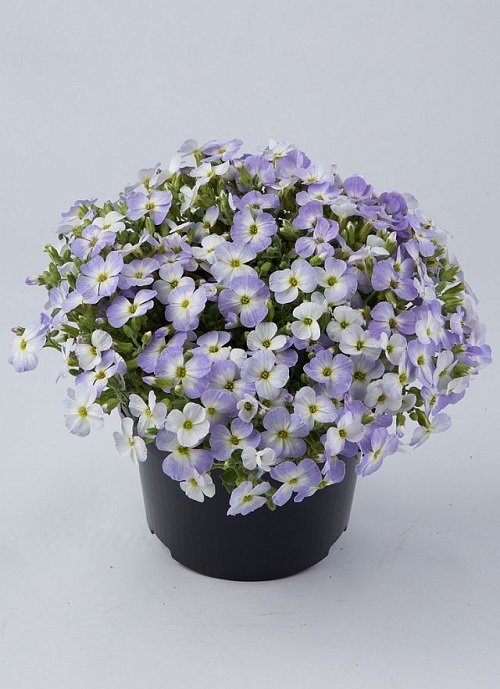
Botanical Name: Helianthemum ‘Blue’
- Type: Low-growing evergreen shrub
- Origin: North America
- Size: Up to 1 foot tall
- Light Requirements: Full sun
- USDA Hardiness Zones: 6-8
Blueblush flowers exude elegance with their pale blue hues. Blueblush is a low-growing evergreen shrub that produces beautiful blue flowers with a touch of white and a blush of yellow in the center.
Growing Tip: Blueblush, a low-growing ground cover, thrives in direct sun and well-draining soil. It’s known for its striking blue blooms. Ensure good air circulation to prevent mildew, and trim it back after flowering to maintain a neat appearance. This perennial adds a delightful blue hue to your landscape.
17. Blue Flossflower
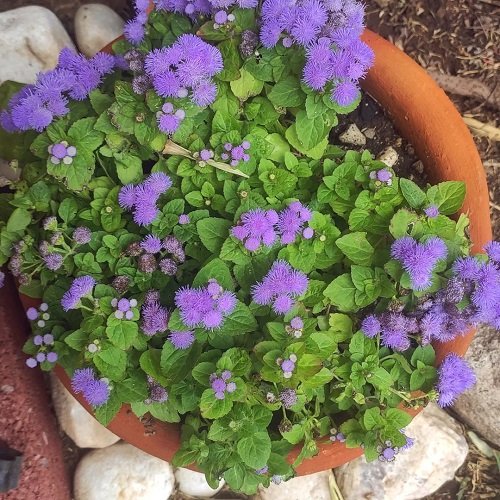
Botanical Name: Ageratum houstonianum
- Type: Annual
- Origin: Mexico and Central America
- Size: Up to 2 feet tall
- Light Requirements: Full sun to light shade
- USDA Hardiness Zones: 2-11
Blue Flossflower is a delightful annual known for its clusters of small, fluffy blue blooms, gracefully earning its place among the most beloved blue flower names in horticulture.
Growing Tip: Blue Flossflowers are compact annuals that prefer full sun to light shade. Plant them in well-drained soil and deadhead spent blossoms regularly for a profusion of fluffy blue blooms all season. They’re excellent for edging, containers, or as bedding plants.
18. Blue Lupine
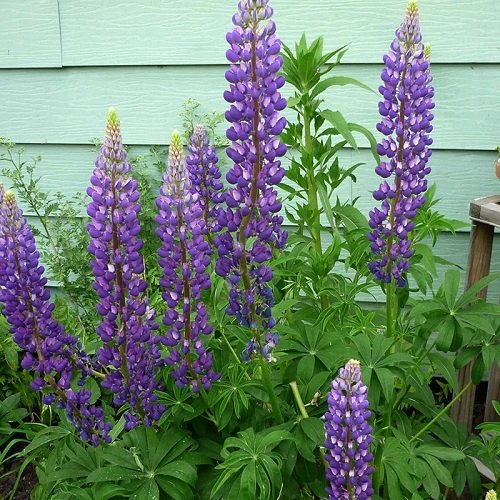
Botanical Name: Lupinus perennis
- Type: Herbaceous perennial
- Origin: North America
- Size: Up to 3 feet tall
- Light Requirements: Full sun
- USDA Hardiness Zones: 3-8
Blue Lupine flowers are like the jewels of the garden. Their vibrant cobalt-blue petals make them a striking addition to any landscape, radiating a sense of grandeur. Blue Lupines are renowned for their beauty among blue and white flowers.
Growing Tip: Blue Lupines are native wildflowers that prefer well-drained, sandy soil and full sun. These hardy perennials attract pollinators with their vibrant blue spires. Allow some of the spent flowers to go to seed to encourage their return in subsequent years.
19. Blue Mist Shrub
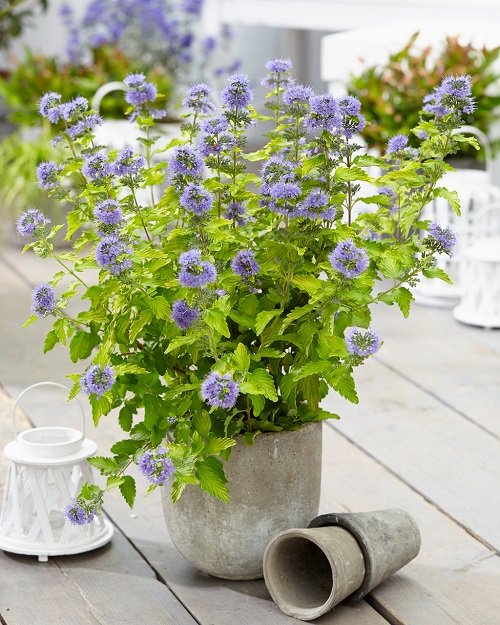
Botanical Name: Caryopteris x clandonensis
- Type: Deciduous shrub
- Origin: North America and East Asia
- Size: Up to 4 feet tall
- Light Requirements: Full sun to light shade
- USDA Hardiness Zones: 5-9
Blue Mist Shrubs are like a dream among sweet blue flowers. The Blue Mist Shrub’s flowers, in shades of silver and blue, create an enchanting misty effect in your garden. These ethereal blooms seem to beckon you to a world of tranquility.
Growing Tip: Blue Mist Shrubs are drought-tolerant and thrive in full sun. They produce clusters of tiny blue flowers that butterflies adore. Prune them back in early spring to encourage new growth and a profusion of blossoms. These shrubs add a touch of blue elegance to your garden.
20. Blue Larkspur
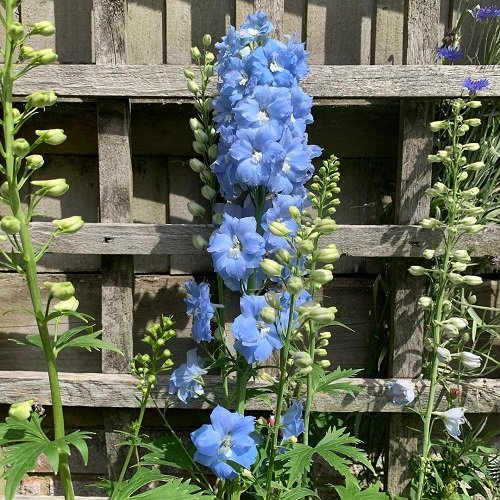
Botanical Name: Delphinium nuttallianum
- Type: Herbaceous perennial
- Origin: North America
- Size: Up to 4 feet tall
- Light Requirements: Full sun to light shade
- USDA Hardiness Zones: 4-8
Standing tall and majestic, the Blue Larkspur adds regal beauty to your garden. With its deep blue spikes of blossoms, it’s like a majestic scepter gracing your floral kingdom. These types of blue flowers are sure to make a bold statement in your garden.
Growing Tip: Blue Larkspur, a native wildflower, prefers bright sunlight and well-draining soil. These tall, elegant spires of blue blooms make a dramatic statement in the garden. Stake them for support, as they can grow quite tall. Deadheading spent flowers keeps them looking tidy and encourages more blooms throughout the season.
21. Blue Daze

Botanical Name: Evolvulus glomeratus
- Type: Perennial ground cover
- Origin: South America
- Size: Up to 1 foot tall and 2-3 feet wide
- Light Requirements: Full sun
- USDA Hardiness Zones: 8-11
Blue Daze offers a slice of the clear summer sky with its delicate petals that embody tranquility. These perennial blooms are known for their captivating light blue flowers that evoke a sense of serenity.
Growing Tip: Blue Daze, a charming annual, thrives in bright, direct sunlight and well-draining soil. Its bright blue, trumpet-shaped flowers bloom profusely. Water consistently to keep the soil evenly moist, and consider adding a layer of mulch to retain moisture. Prune back occasionally to encourage bushier growth and more blossoms.
22. Blue Passionflower
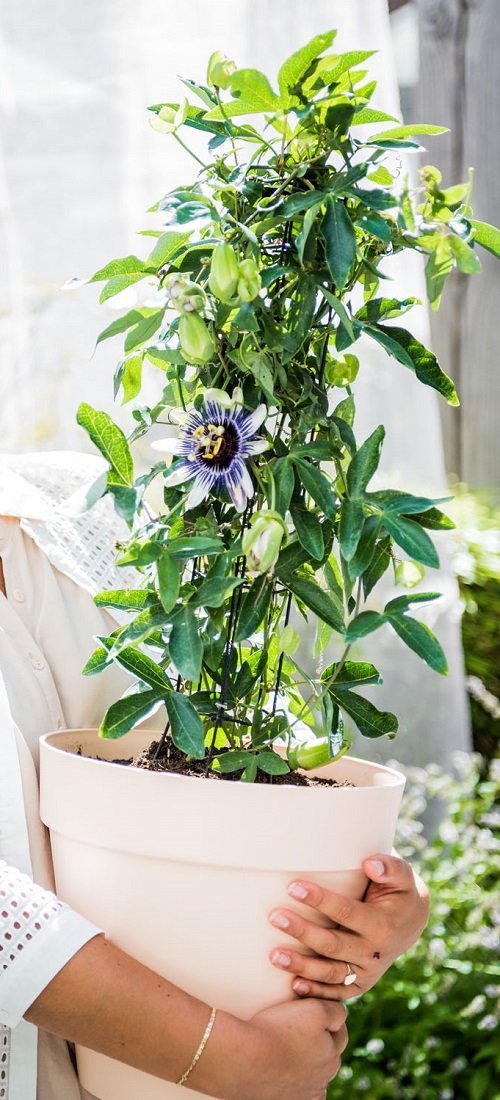
Botanical Name: Passiflora caerulea
- Type: Perennial vine
- Origin: South America
- Size: Up to 20 feet long
- Light Requirements: Full sun to light shade
- USDA Hardiness Zones: 6-11
Blue Passionflower is a vine that showcases exotic beauty with its mesmerizing blue and purple flowers. These blooms, resembling works of art, are visually captivating and also fragrant, enticing both your senses and curious butterflies.
Growing Tip: Blue Passionflower is a tropical vine that adores sunlight. Plant it in rich, well-draining soil and provide sturdy support for its vigorous growth. These exotic blue and white flowers are followed by edible fruit. Prune lightly in late winter to maintain its shape and encourage new blooms.
23. Blue Fan Flower
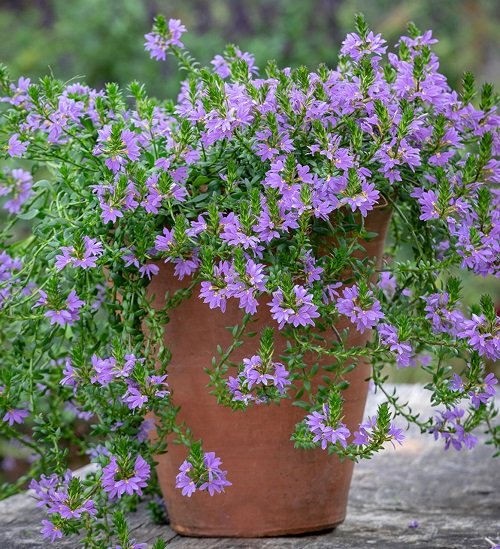
Botanical Name: Scaevola aemula
- Type: Perennial ground cover
- Origin: Australia
- Size: Up to 1 foot tall and 3-4 feet wide
- Light Requirements: Full sun to light shade
- USDA Hardiness Zones: 10-11
Blue Fan Flower is a unique perennial with elegant blue bell flowers that seem to resemble delicate fans. These blooms gracefully cascade from their branches, creating a gentle, mesmerizing effect.
Growing Tip: Blue Fan Flower, also known as the Fairy Fan Flower, loves full sun and well-drained soil. Its cascading blue blossoms add a touch of elegance to hanging baskets and containers. Deadheading spent flowers keeps them tidy and promotes a continuous display of color.
24. Blue False Indigo

Botanical Name: Baptisia australis
- Type: Herbaceous perennial
- Origin: North America
- Size: Up to 4 feet tall
- Light Requirements: Full sun to light shade
- USDA Hardiness Zones: 3-9
Blue False Indigo offers a delightful burst of blue in your garden with vibrant flowers. These blossoms stand tall and proud, making a statement in any landscape. Their unique appearance and striking color make Blue False Indigo a standout choice for garden enthusiasts.
Growing Tip: Blue False Indigo is a native perennial that thrives in full sun to light shade. It’s known for its striking blue, lupine-like flowers on tall spikes. These plants are drought-tolerant once established, and they enrich the soil with nitrogen. Prune back in late spring to maintain a neat appearance and encourage more blooms.
25. Poppy Anemone
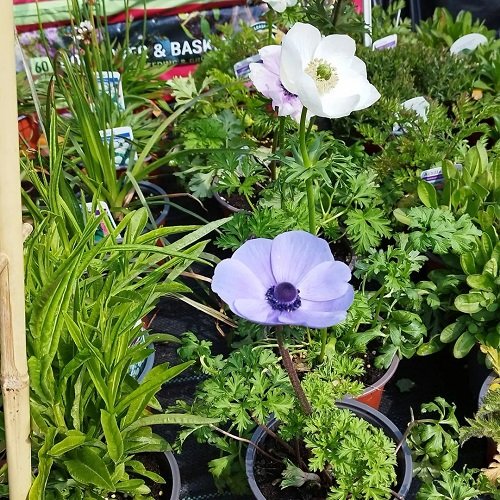
Botanical Name: Anemone coronaria ‘Blue Poppy’
- Type: Annual or perennial
- Origin: Mediterranean
- Size: Up to 1.5 feet tall and .75 feet wide
- Light Requirements: Full sun to light shade
- USDA Hardiness Zones: 7-10
These annual or perennial blossoms add a vibrant touch to your garden, making them a favorite choice for those seeking a burst of color. Poppy Anemone is a charming addition to any landscape.
Growing Tip: Poppy Anemones are cool-season plants that prefer well-drained soil and plenty of sun. Their vibrant blue, daisy-like flowers bloom in spring. Plant the tubers in the fall for an early burst of color. After flowering, let the foliage die back naturally to nourish the tubers for the next season’s display.
26. Blue Star Creeper
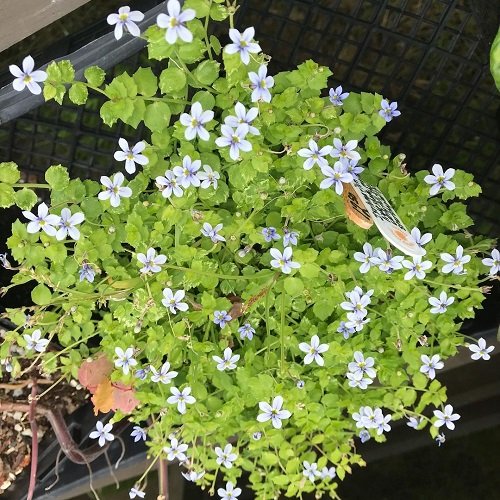
Botanical Name: Laurentia fluviatilis
- Type: Perennial ground cover
- Origin: New Zealand and Australia
- Size: Up to 3 inches tall and 2 feet wide
- Light Requirements: Full sun to light shade
- USDA Hardiness Zones: 6-9
Blue Star Creeper is a ground-hugging perennial that creates a mesmerizing carpet of sweet blue flowers. Its tiny, star-shaped blooms create a magical effect, resembling a starry night sky.
Growing Tip: Blue Star Creeper is a low-growing ground cover that’s excellent for suppressing weeds. It thrives in partial shade to full sun and adapts well to various soil types. To encourage its spread, plant it close together and water it regularly until established.
27. Blue Statice
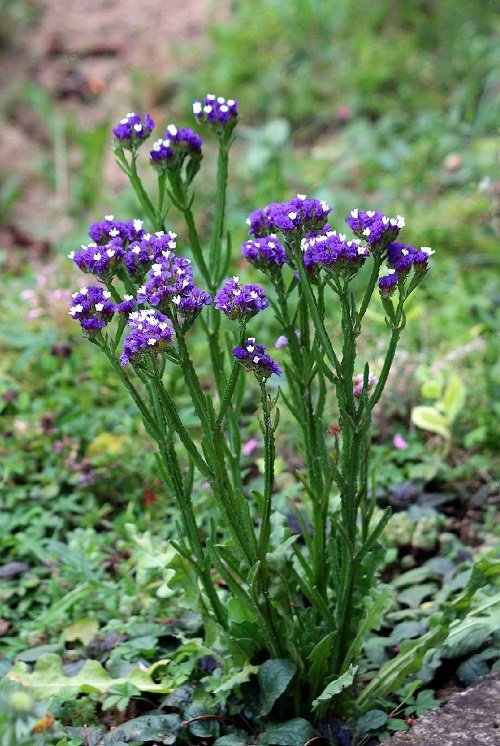
Botanical Name: Limonium sinuatum
- Type: Annual
- Origin: Europe and Asia
- Size: Up to 2 feet tall
- Light Requirements: Full sun
- USDA Hardiness Zones: 8-11
Blue Statice is cherished among blue flowering plants that are often used in dried flower arrangements. These blooms symbolize everlasting beauty, making them a sentimental choice for gardens.
Growing Tip: Blue Statice, also known as Sea Lavender, is prized for its papery flowers. These annuals prefer well-drained soil and full sun. To extend their vase life, cut the flowers for drying when they’re at their peak and hang them upside down.
28. Blue Fringed Sage
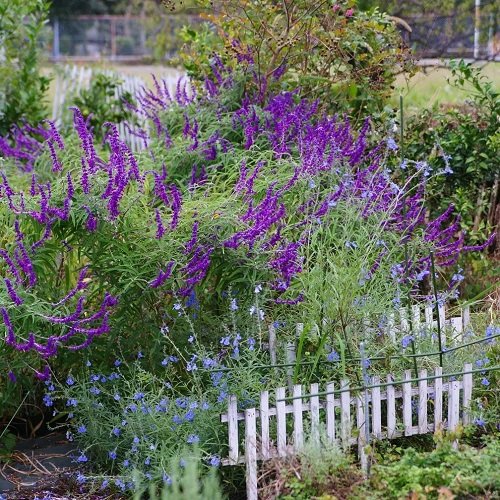
Botanical Name: Salvia azurea
- Type: Herbaceous perennial
- Origin: North America
- Size: Up to 4 feet tall
- Light Requirements: Full sun
- USDA Hardiness Zones: 5-9
Blue Fringed Sage offers a burst of blue in your garden with its graceful spikes of blue spring flowers. These blossoms are not only visually captivating but also attract pollinators like bees and butterflies.
Growing Tip: Blue Fringed Sage is a hardy perennial that attracts pollinators. Plant it in a sunny spot with well-drained soil. Prune back in early spring to promote bushier growth and increase flower production. These sage plants are drought-tolerant once established.
29. Blue Geranium
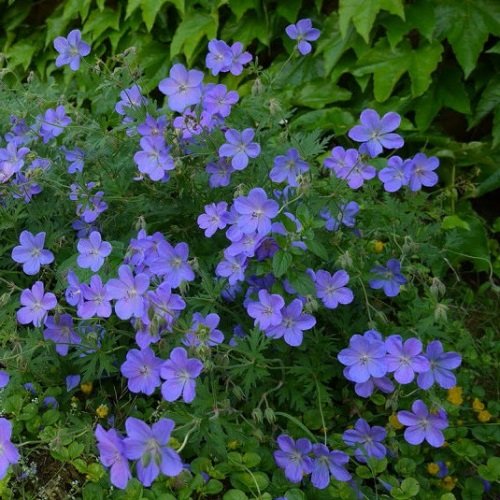
Botanical Name: Geranium dissectum
- Type: Herbaceous perennial
- Origin: Europe and Asia
- Size: Varies depending on the species
- Light Requirements: Full sun to light shade
- USDA Hardiness Zones: 4-9
Blue Geranium is a perennial favorite with its charming small blue flowers. These blooms add a touch of elegance to your garden with their delicate appearance. Blue Geranium’s timeless beauty makes it a cherished choice for garden enthusiasts.
Growing Tip: Blue Geranium, also known as Cutleaf Geranium, is a low-maintenance perennial. It thrives in partial shade to full sun and adapts to various soil types. To prevent self-seeding, deadhead spent blossoms and cut back the plant after its initial bloom to encourage a second flush of flowers.
30. Blue Balloon Vine

Botanical Name: Cardiospermum halicacabum
- Type: Perennial vine
- Origin: Tropical regions
- Size: Up to 10 feet long
- Light Requirements: Full sun to light shade
- USDA Hardiness Zones: 10-11
Blue balloon vine is a unique annual that produces stunning dark blue flowers. These whimsical blooms add a playful element to your garden, making them a delightful choice for those seeking a touch of whimsy.
Growing Tip: Blue Balloon Vine is a fast-growing climber known for its unique seed pods. Plant it in full sun and well-drained soil. Provide a sturdy trellis or support structure for the vine to climb. To collect the decorative balloon-like seed pods, wait until they mature and turn papery brown.
31. Blue Pimpernel

Botanical Name: Anagallis monellii
- Type: Annual or perennial
- Origin: South America
- Size: Up to 6 inches tall and 1-2 feet wide
- Light Requirements: Full sun to light shade
- USDA Hardiness Zones: 7-10
The delicate blue flowers of the Blue Pimpernel are reminiscent of an evening sky. This perennial beauty boasts vibrant blooms that are a true testament to nature’s amazing beauty.
Growing Tip: Blue Pimpernel is a low-maintenance plant that thrives in well-drained soil. It’s known for its resilience in dry conditions. To encourage continuous blooming, remove spent flowers regularly. This plant’s adaptability makes it a suitable choice for rock gardens and containers.
32. Bluebell Vine
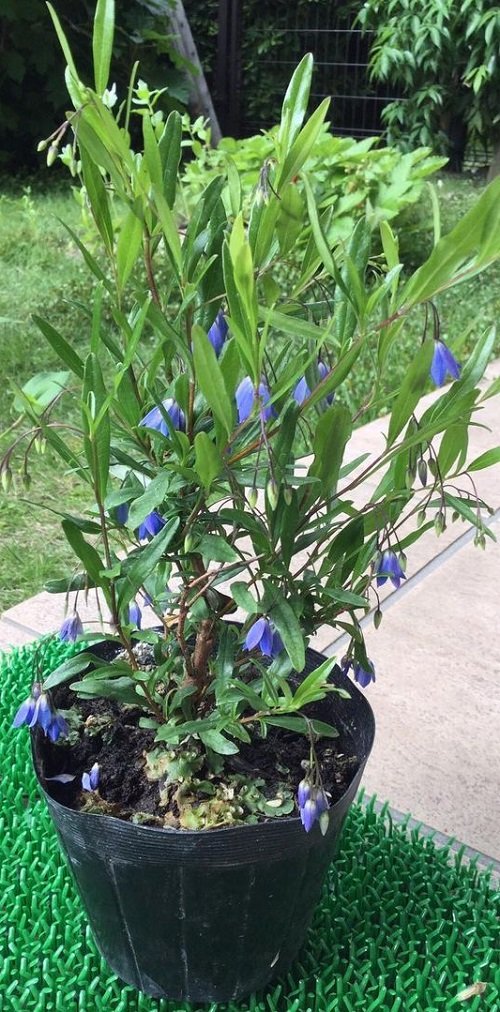
Botanical Name: Billardiera heterophylla
- Type: Perennial vine
- Origin: Australia
- Size: Up to 20 feet long
- Light Requirements: Full sun to light shade
- USDA Hardiness Zones: 8-10
Bluebell vine, also known as Australian Bluebell creeper, is a beautiful and easy-to-grow climber. Its elegant, pendulous blossoms resemble tiny bells swaying in the breeze. These blue bell flowers make a charming addition to any garden.
Growing Tip: Bluebell Vine is a vigorous climber that requires a sturdy support structure. Plant it in full sun to partial shade and well-draining soil. Prune back any unruly growth to maintain its shape and encourage more branching, which leads to more flowers.
33. Blue Sky Vine

Botanical Name: Thunbergia grandiflora
- Type: Perennial vine
- Origin: Tropical regions
- Size: Up to 20 feet long
- Light Requirements: Full sun to light shade
- USDA Hardiness Zones: 9-11
Blue Sky Vine’s sky-blue perennial flowers bring a sense of calm and serenity to outdoor spaces, truly living up to its name.
Growing Tip: Blue Sky Vine is a fast-growing, tropical climber. It loves the bright sun and well-draining soil. Regularly train its vines to grow where you want them by gently tying them to a trellis or support. Pruning in early spring can help control its size and promote new growth.
34. Blue Woodruff
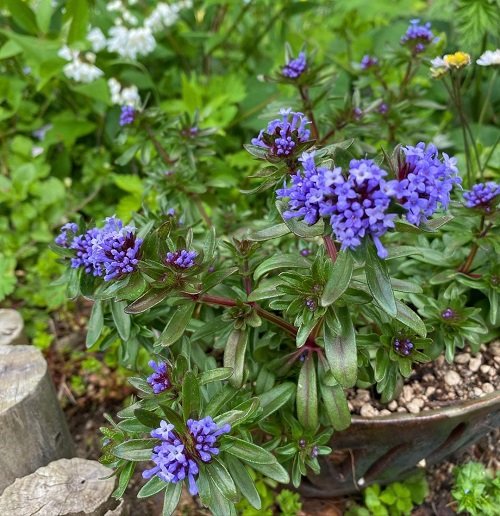
Botanical Name: Asperula orientalis
- Type: Herbaceous perennial
- Origin: Europe and Asia
- Size: Up to 1 foot tall
- Light Requirements: Full sun to light shade
- USDA Hardiness Zones: 4-10
Found in woodlands, Blue Woodruff’s small blue flowers offer subtle natural beauty, reminiscent of wild flowers.
Growing Tip: Blue Woodruff is a hardy ground cover plant that prefers partial to full shade. It’s adaptable to various soil types. To prevent it from spreading too aggressively, trim back its growth in early spring and remove any dead or yellowing leaves.
35. Blue Foxglove

Botanical Name: Digitalis purpurea
- Type: Biennial or short-lived perennial
- Origin: Europe and Asia
- Size: Up to 4 feet tall
- Light Requirements: Full sun to light shade
- USDA Hardiness Zones: 4-9
Blue Foxglove stands tall with its graceful spikes of beautiful blue flowers, a beloved choice for garden enthusiasts.
Growing Tip: Blue Foxglove, a biennial or short-lived perennial, needs well-drained soil and partial shade. To encourage self-seeding, allow some flower spikes to produce seeds. Pruning spent spikes can prolong its lifespan, but remember that it may take a year or two to flower again.
36. Blue Creeping Phlox

Botanical Name: Phlox subulata
- Type: Perennial ground cover
- Origin: North America
- Size: Up to 6 inches tall and 2 feet wide
- Light Requirements: Full sun
- USDA Hardiness Zones: 3-9
Planting blue creeping phlox is a great way to create a lovely blue flowers ground cover that will cascade beautifully over rocks and walls.
Growing Tip: Blue Creeping Phlox is an excellent ground cover for sunny areas with well-draining soil. After the initial spring bloom, trim it back lightly to encourage denser growth and sporadic reblooms throughout the year.
37. Blue Dwarf Iris
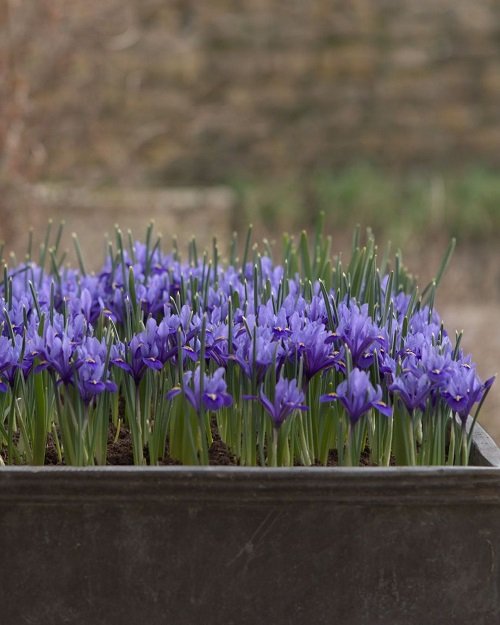
Botanical Name: Iris reticulata
- Type: Bulbous perennial
- Origin: Asia Minor and Caucasus
- Size: Up to 6 inches tall
- Light Requirements: Full sun to light shade
- USDA Hardiness Zones: 5-8
The Blue Dwarf Iris, with its vivid indigo hue, adds a pop of color to gardens, a charming choice among blue perennial flowers.
Growing Tip: Blue Dwarf Iris is a petite, early spring bloomer that thrives in well-drained soil and full sun. Plant the bulbs in the fall for a burst of color. After flowering, allow the foliage to wither naturally to nourish the bulbs for the next season.
38. Blue Dayflower

Botanical Name: Commelina communis
- Type: Annual or perennial
- Origin: Asia
- Size: Up to 2 feet tall
- Light Requirements: Full sun to light shade
- USDA Hardiness Zones: 6-9
Blue dayflower is a low-maintenance plant that can spread quickly, making it a great choice for ground cover or edging.
Growing Tip: Blue Dayflower is an adaptable, low-growing plant that can thrive in various soil types. It’s known for its tendency to self-seed abundantly. To prevent it from becoming invasive, deadhead spent flowers and remove any unwanted seedlings.
39. Blue Water Hyacinth
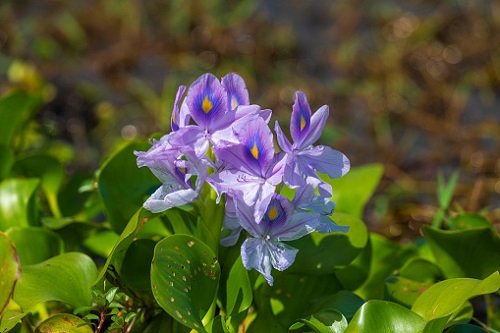
Botanical Name: E. crassipes
- Type: Aquatic plant
- Origin: South America
- Size: Floats on water’s surface
- Light Requirements: Full sun
- USDA Hardiness Zones: 8-11
Blue water hyacinth is an aquatic plant with lovely blue and purple flowers that float on the water’s surface. These flowers are a wonderful option to provide both aesthetic and ecological benefits to your water garden.
Growing Tip: Blue Water Hyacinth is a floating aquatic plant. It helps improve water quality in ponds and water gardens. Regularly thin the population to prevent overcrowding and maintain a healthy ecosystem. Remove dead or decaying leaves to keep the water surface clear.
40. Blue Butterfly Bush
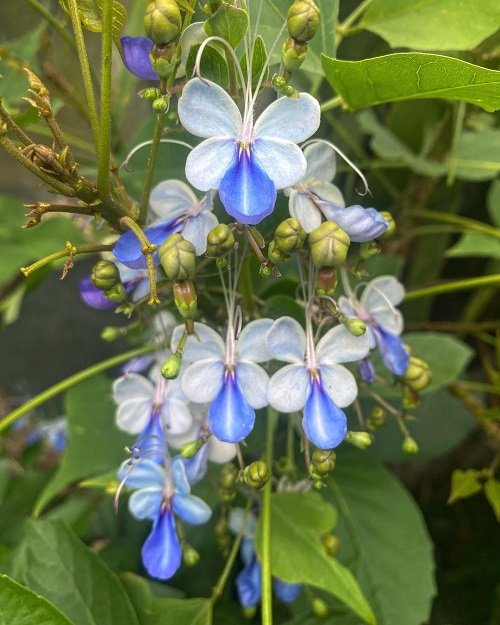
Botanical Name: Buddleja davidii
- Type: Deciduous shrub
- Origin: Asia and Africa
- Size: Up to 15 feet tall
- Light Requirements: Full sun
- USDA Hardiness Zones: 5-10
The Blue Butterfly Bush, adorned with fragrant violet-blue spikes, is a favorite among those looking to attract wildlife with blue flowers.
Growing Tip: Blue Butterfly Bush is a sun-loving shrub that attracts pollinators. Pruning is essential in late winter to remove old growth and encourage new shoots. Deadhead spent flower spikes to promote continuous blooming throughout the summer.
41. Blue Dahlia
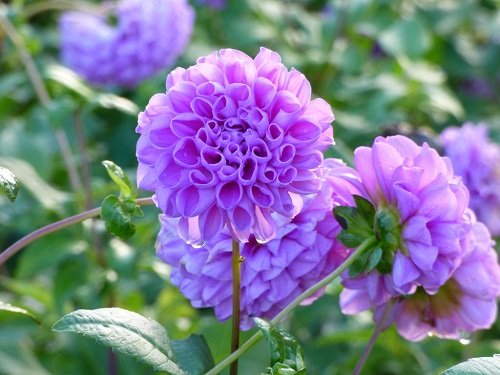
Botanical Name: Dahlia pinnata
- Type: Tuberous perennial
- Origin: Central and South America
- Size: Varies depending on the variety
- Light Requirements: Full sun to light shade
- USDA Hardiness Zones: 8-10
The Blue Dahlia, with its striking petals reminiscent of a clear summer sky, is a true marvel in the garden. Its vibrant hues make it one of the most sought-after blue flowers. This perennial beauty stands as a symbol of elegance and grace, enchanting all who lay eyes upon it.
Growing Tip: Blue Dahlias thrive in well-drained, fertile soil. To encourage a profusion of blooms, pinch off the lateral buds early in the growing season, leaving only the central bud to develop into a larger flower. Stake the plants as they grow to support their tall stems.
42. Blue Hibiscus

Botanical Name: Alyogyne huegelii
- Type: Shrub
- Origin: Australia
- Size: Up to 6 feet tall
- Light Requirements: Full sun to light shade
- USDA Hardiness Zones: 5-11
Among the various blue bonnet flowers, the Blue Hibiscus reigns supreme with its velvety azure blossoms. Hailing from the warmer regions, its tropical allure adds a touch of exoticism to any landscape, making it a must-have for garden enthusiasts.
Growing Tip: Blue Hibiscus prefers full sun and well-draining soil. Pruning the plant in late winter or early spring helps maintain its shape and encourages bushier growth. To enhance flowering, fertilize sparingly in the growing season.
43. Blue Phlox
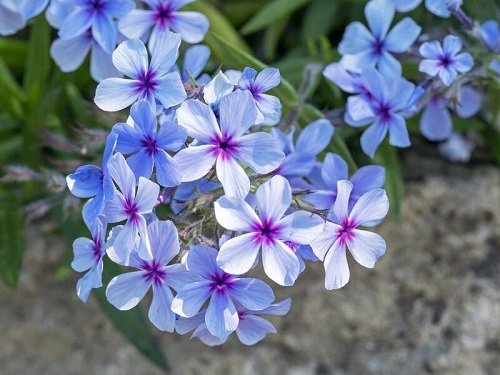
Botanical Name: Phlox divaricata
- Type: Herbaceous perennial
- Origin: North America
- Size: Up to 1 foot tall
- Light Requirements: Full sun to light shade
- USDA Hardiness Zones: 3-8
The Blue Phlox, a woodland wonder, carpets the forest floor with its delicate blooms. The fascinating thing about growing blue phlox is that – they readily self-seeds and can be propagated by division in the fall or early spring.
Growing Tip: Blue Phlox, a woodland perennial, prefers partial shade and well-drained, slightly acidic soil. Divide the clumps every few years to rejuvenate the plant and promote healthier growth. Regularly remove any dead or yellowing leaves to keep it looking tidy.
44. Blue Daisy
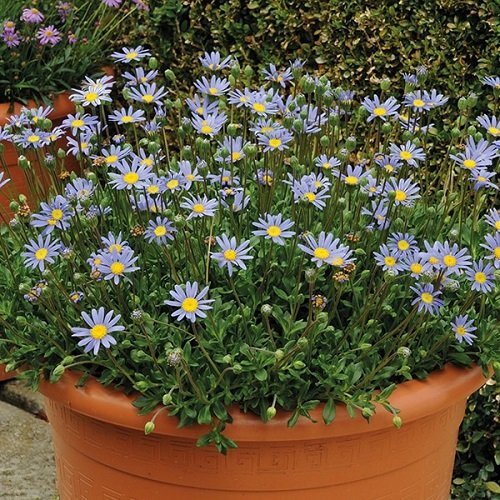
Botanical Name: Felicia amelloides
- Type: Perennial
- Origin: South Africa
- Size: Up to 2 feet tall
- Light Requirements: Full sun
- USDA Hardiness Zones: 9-11
Blue daisy, also known as Blue Marguerite, is a popular South African plant with a lovely daisy-like blue flowers aesthetic. As one of the loveliest blue flowers, it pairs beautifully with other garden companions to spruce up the space.
Growing Tip: Blue Daisies thrive in bright sun and well-drained fertile soil. Deadheading spent flowers encourages continuous blooming. Pruning the plant back in early spring helps maintain its shape and encourages more compact growth.
45. Blue Violets
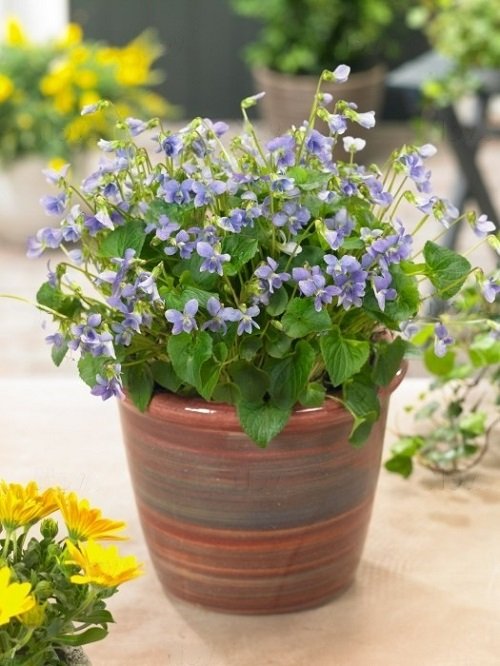
Botanical Name: Viola sororia
- Type: Perennial
- Origin: North America
- Size: Varies depending on the species
- Light Requirements: Partial to full shade
- USDA Hardiness Zones: 3-7
The beautiful blue violets are easy to grow as they just need partial to full shade and moist soil. Among the natural blue flowers, these delicate blooms captivate with their understated beauty and are often cherished for their symbolism of faithfulness.
Growing Tip: Blue Violets are hardy ground cover plants that adapt to various soil types. To encourage natural spreading, let them self-seed or divide established clumps. Regularly remove any invasive weeds that might compete with them.
46. Brunnera

Botanical Name: Brunnera macrophylla
- Type: Perennial
- Origin: Europe and Asia
- Size: Up to 1 foot tall
- Light Requirements: Full to partial shade
- USDA Hardiness Zones: 3-7
With heart-shaped leaves and delicate blue and white flowers, Brunnera is the embodiment of elegance in your garden. These perennial plants are known for their remarkable resilience, thriving in various climates and enchanting with their cool-toned blooms.
Growing Tip: Brunnera, also known as Siberian Bugloss, thrives in partial to full shade and well-drained soil. To keep the plant healthy and compact, cut back the flowering stems after they bloom. Mulching helps maintain soil moisture and keeps the root zone cool.
47. Canterbury Bells
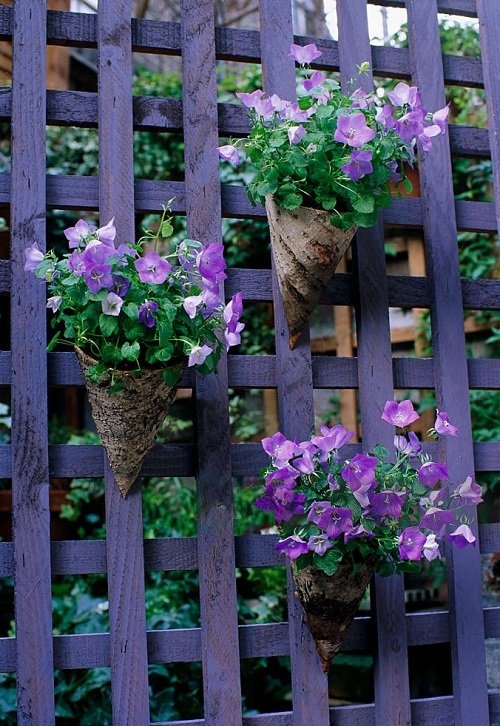
Botanical Name: Campanula medium
- Type: Biennial
- Origin: Southern Europe
- Size: Up to 3 feet tall
- Light Requirements: Full sun to light shade
- USDA Hardiness Zones: 4-10
The sweet blue flowers of Canterbury Bells, or Campanula medium, are a nostalgic reminder of traditional cottage gardens. These biennial blooms sway gracefully in the breeze, creating a picturesque scene that embodies rustic charm.
Growing Tip: Canterbury Bells are biennial plants that thrive in full sun to partial shade and well-drained soil. To encourage self-seeding, allow some seed pods to mature and drop seeds naturally. Deadhead spent blooms to redirect energy for seed production.
48. Chicory
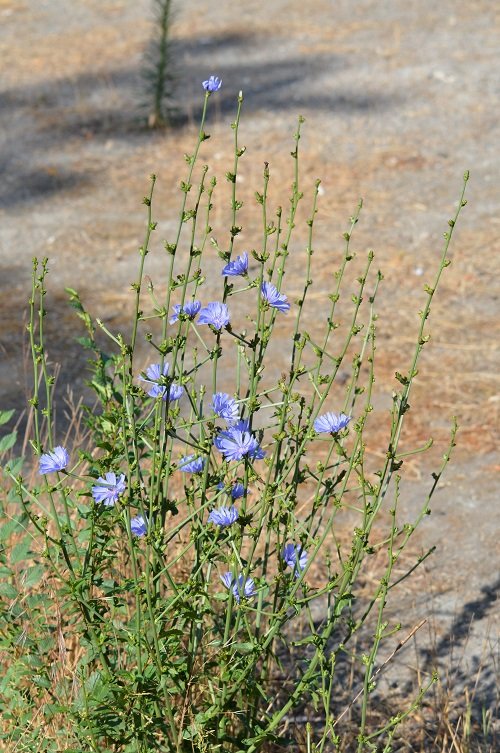
Botanical Name: Cichorium intybus
- Type: Perennial herb
- Origin: Eurasia
- Size: Up to 4 feet tall
- Light Requirements: Full sun
- USDA Hardiness Zones: 3-10
Chicory, or Cichorium intybus, is a symbol of endurance among blue flowering plants. Its vibrant blue petals stand tall, even in challenging environments.
Growing Tip: Chicory is a hardy, wild plant that adapts to different soil types. To prevent it from becoming invasive, cut back the flowering stems after they bloom. Harvest the leaves when they are young for a less bitter taste if you plan to use them in salads.
49. Cornflower
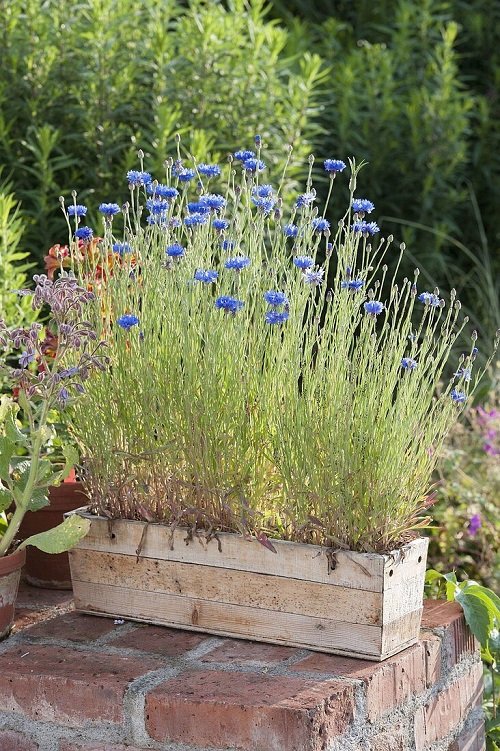
Botanical Name: Centaurea cyanus
- Type: Annual
- Origin: Europe
- Size: Up to 3 feet tall
- Light Requirements: Full sun
- USDA Hardiness Zones: 2-11
As one of the most recognized blue flowers, the Cornflower, or Centaurea cyanus, graces fields with its vibrant blooms. These blue and purple flowers are a favorite among pollinators and garden enthusiasts alike, adding a pop of color to any landscape.
Growing Tip: Cornflowers are adaptable annuals that prefer full sun and well-draining soil. Deadhead spent flowers to prolong blooming. Let some flowers go to seed if you want them to self-sow for the next season.
50. Catmint
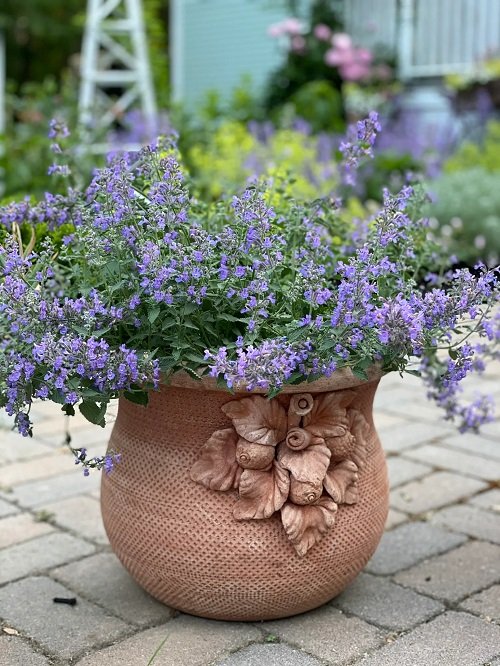
Botanical Name: Nepeta
- Type: Perennial
- Origin: Europe and Asia
- Size: Up to 2 feet tall
- Light Requirements: Full sun to light shade
- USDA Hardiness Zones: 3-9
Catmints are attractive and long-lasting blue flowers for the garden. This perennial herb’s aesthetic and aromatic leaves make it a delightful addition to any home.
Growing Tip: Catmint is a resilient perennial that thrives in the sun, so give it plenty of bright light. To keep the plant compact and encourage reblooming, shear it back by about one-third after the initial bloom. This will also help prevent it from becoming too leggy.
51. Delphinium

Botanical Name: Delphinium
- Type: Herbaceous perennial
- Origin: Northern Hemisphere
- Size: Varies depending on the species
- Light Requirements: Full sun to light shade
- USDA Hardiness Zones: 3-7
Delphiniums, with their majestic spires of blue delphinium flowers, are reminiscent of medieval gardens. These towering beauties are often associated with dignity and grace, lending a regal air to the landscape.
Growing Tip: Delphiniums thrive in well-draining soil with a neutral to slightly alkaline pH. To support their tall growth, stake the plants and keep them sheltered from strong winds. Regularly deadhead spent flower spikes to encourage more blooms and prevent self-seeding.
52. Clematis
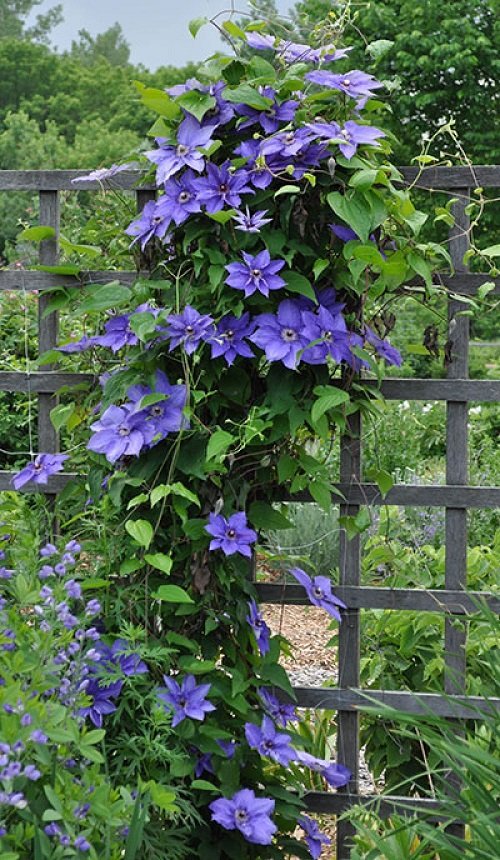
Botanical Name: Clematis x jackmanii
- Type: Perennial vine
- Origin: Various regions
- Size: Varies depending on the variety
- Light Requirements: Full sun to light shade
- USDA Hardiness Zones: 3-9
Clematis are a stunning addition to any space. They produce large, showy blue flowers in a wide range of colors, including pink, purple, blue, white, and red.
Growing Tip: Clematis is a climbing vine that prefers cool roots and sunlight on its foliage. Mulch around the base to keep the roots cool, and provide a support structure for its growth. Prune in late winter or early spring to remove dead or weak stems and promote vigorous new growth.
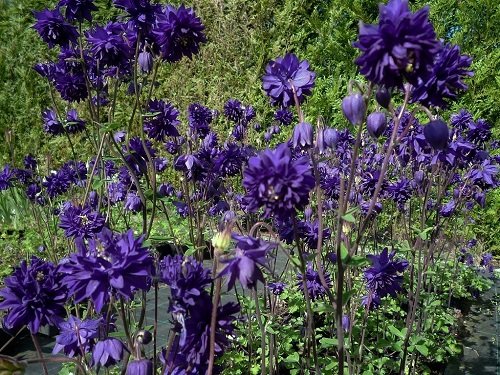
Botanical Name: Aquilegia vulgaris var. stellata
- Type: Herbaceous perennial
- Origin: North America
- Size: Up to 1 foot tall
- Light Requirements: Full sun to light shade
- USDA Hardiness Zones: 3-9
Nestled among emerald leaves, these delicate blossoms adorn gardens with their mesmerizing hues of blue, resembling the dark evening sky. They bloom gracefully, captivating all who encounter their charm.
Growing Tip: Dwarf Blue Columbines adapt well to various soil types. To maintain their compact form and encourage blooming, shear back the plant after the initial flush of flowers. This will also help take care of self-seeding challenges.
54. Slender Dwarf Morning Glory
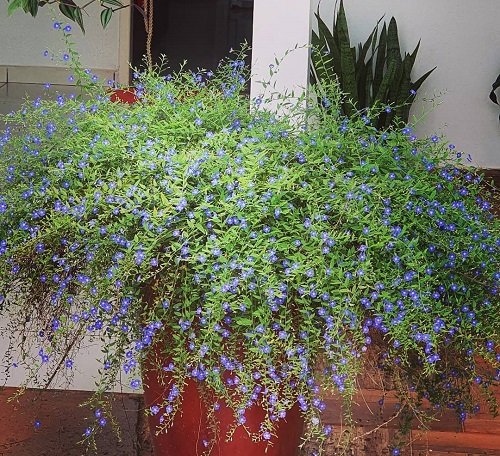
Botanical Name: Evolvulus alsinoides
- Type: Annual
- Origin: North America
- Size: Up to 1 foot tall and 2-3 feet wide
- Light Requirements: Full sun
- USDA Hardiness Zones: 9-11
In meadows and rocky crevices, you’ll find the Slender Dwarf Morning Glory, a petite wonder with vibrant blue petals.
Growing Tip: Slender Dwarf Morning Glory is a low-growing ground cover that basks in the bright direct light of the sun and requires well-drained soil. Pruning or shearing the plant periodically helps maintain a tidy appearance and encourages dense growth.
55. English Bluebell Creeper
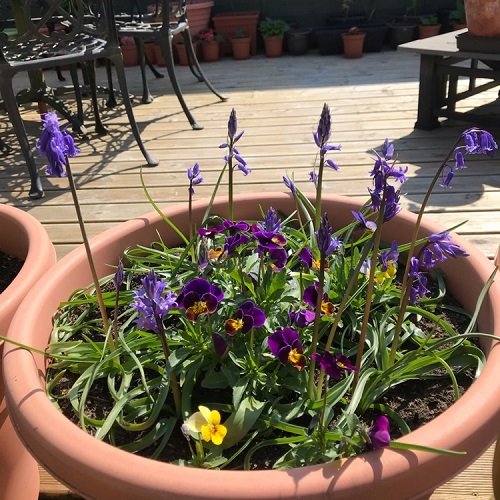
Botanical Name: Hyacinthoides non-scripta
- Type: Bulbous perennial
- Origin: Europe
- Size: Up to 1 foot tall
- Light Requirements: Full sun to light shade
- USDA Hardiness Zones: 4-9
Draping itself in tendrils of elegance, the English Bluebell Creeper boasts clusters of blossoms akin to a cascade of blue bells flowers. It’s a sight to behold in the woodlands, enchanting you with its timeless allure.
Growing Tip: English Bluebell Creeper is a bulbous plant that prefers partial shade and well-drained soil. Allow the foliage to die back naturally after blooming to nourish the bulbs for the next season. Avoid overcrowding by dividing bulbs every few years.
56. Forget-Me-Nots
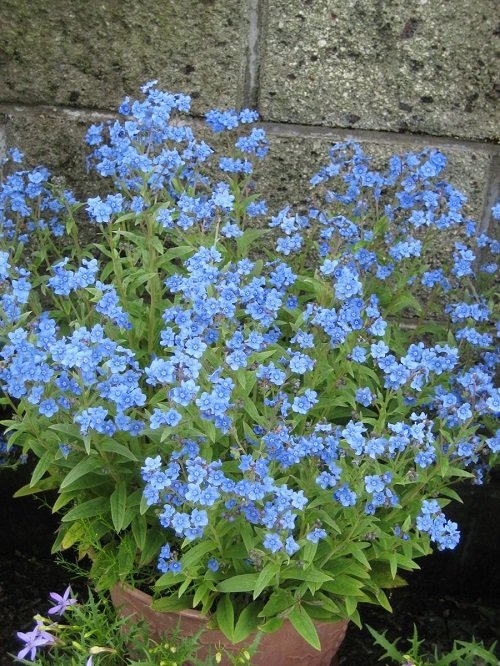
Botanical Name: Myosotis scorpioides
- Type: Annual or biennial
- Origin: Europe and Asia
- Size: Up to 1 foot tall
- Light Requirements: Full sun to light shade
- USDA Hardiness Zones: 5-9
Forget-me-nots are lovely cool-season plants that produce small blue, pink, or white flowers in spring.
Growing Tip: Forget-Me-Nots are adaptable plants that prefer moist soil and partial shade. To encourage self-seeding, let some flowers go to seed naturally. Deadhead spent blooms to redirect energy for seed production.
57. Flax Flower

Botanical Name: Linum lewisii
- Type: Annual or perennial
- Origin: Worldwide
- Size: Up to 3 feet tall
- Light Requirements: Full sun
- USDA Hardiness Zones: 4a-9b
Flax flowers are a great addition to be grown in containers or used as a border plant. With their light blue color, these blue flowers capture everyone’s attention.
Growing Tip: Flax Flowers prefer full sun and well-draining soil. To encourage a prolonged blooming period, deadhead spent blossoms and shear back the plants after each flush of blooms. This will also help maintain their shape.
58. Gentian
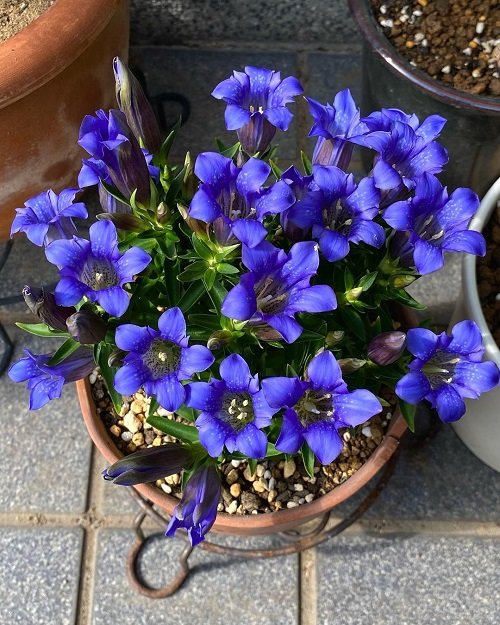
Botanical Name: Gentiana verna
- Type: Herbaceous perennial
- Origin: Europe, Asia, and North America
- Size: Varies depending on the species
- Light Requirements: Full sun to light shade
- USDA Hardiness Zones: 4-7
If you want beautiful royal blue flowers in the spring, then Gentiana verna, also known as Spring Gentian, a small perennial plant, can be a great choice.
Growing Tip: Gentians thrive in well-drained, slightly acidic to neutral soil. These alpine plants prefer cool conditions and benefit from a layer of mulch to keep the soil cool. Prune the plants lightly after flowering to maintain their compact growth.
59. Glory of The Snow

Botanical Name: Chionodoxa luciliae
- Type: Bulbous perennial
- Origin: Turkey
- Size: Up to 6 inches tall
- Light Requirements: Full sun to light shade
- USDA Hardiness Zones: 4-9
As winter yields to spring, these delicate blossoms emerge, earning their name as the “Glory of The Snow,” with hues of blue and white radiating hope.
Growing Tip: Glory of The Snow bulbs prefer well-drained soil and partial sun. Plant them in the fall for an early spring display. After flowering, allow the foliage to wither naturally to nourish the bulbs for the following year.
60. Grape Hyacinth
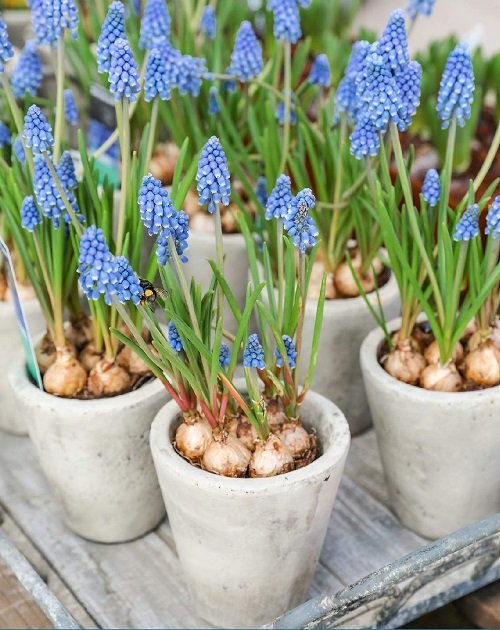
Botanical Name: Muscari armeniacum
- Type: Bulbous perennial
- Origin: Mediterranean region
- Size: Up to 12 inches tall
- Light Requirements: Full sun to light shade
- USDA Hardiness Zones: 4-8
Grape hyacinths are small bulbous plants that produce clusters of fragrant, bell-shaped blue flowers in shades of blue, purple, and white.
Growing Tip: Grape Hyacinths are easy-to-grow bulbs that adapt to various soil types. After flowering, let the foliage die back naturally to nourish the bulbs for the next season. These bulbs multiply over time, creating a lovely carpet of blue.
61. Grecian Wind Flower
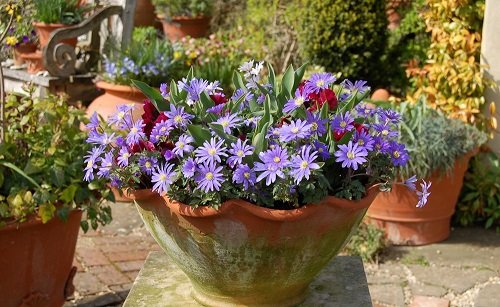
Botanical Name: Anemone blanda
- Type: Bulbous perennial
- Origin: Southeastern Europe and Asia Minor
- Size: Up to 6 inches tall
- Light Requirements: Full sun to light shade
- USDA Hardiness Zones: 4-9
Grecian windflowers are small, early-blooming perennials that produce beautifulblue flowers. They are easy to grow and make a lovely addition to rock gardens, borders, and woodland areas.
Growing Tip: Grecian Wind Flowers prefer partial to full shade and well-drained soil. These bulbs naturalize easily, so plant them in a location where they can spread. After flowering, allow the foliage to wither naturally to store energy for the next season’s blooms.
62. Globe Thistle
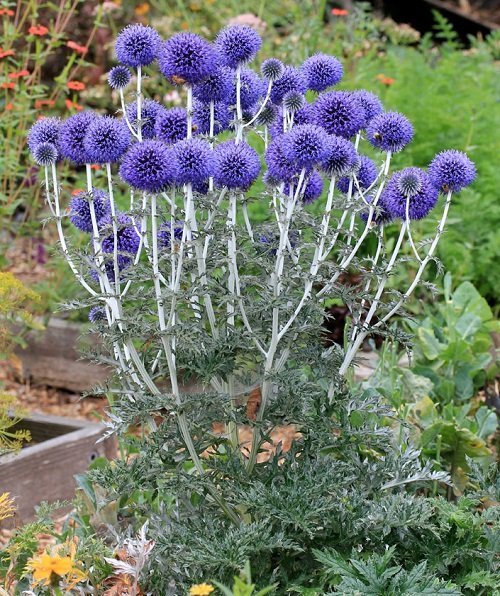
Botanical Name: Echinops ritro
- Type: Herbaceous perennial
- Origin: Europe and Asia
- Size: Up to 4 feet tall
- Light Requirements: Full sun to light shade
- USDA Hardiness Zones: 3-8
Globe Thistle is a beautiful and unique plant that is well-suited for cottage gardens, borders, or as a specimen plant.
Growing Tip: Globe Thistles thrive in full sun and well-draining soil. Deadheading spent flowers can prolong their blooming period. To prevent self-seeding and maintain the plant’s vigor, remove seed heads before they fully mature.
63. Harvestbells
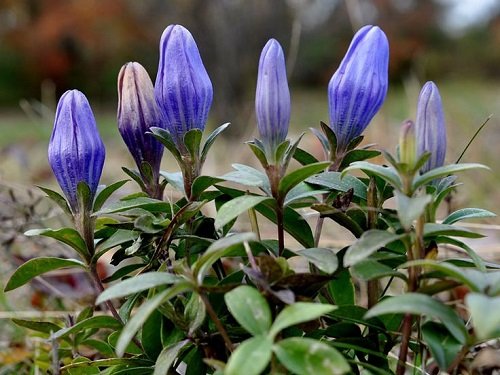
Botanical Name: Ornithogalum saundersiae
- Type: Bulbous perennial
- Origin: South Africa
- Size: Up to 1 foot tall
- Light Requirements: Full sun
- USDA Hardiness Zones: 8-10
The low-maintenance and unique bulbous harvest bells plants produce beautiful blue or white star-shaped flowers in the spring.
Growing Tip: Harvestbell bulbs prefer well-draining soil and full sun to light shade. After flowering, allow the foliage to die back naturally to nourish the bulbs. To encourage spreading, let some bulbs self-seed or divide established clumps.
64. Himalayan Blue Poppy
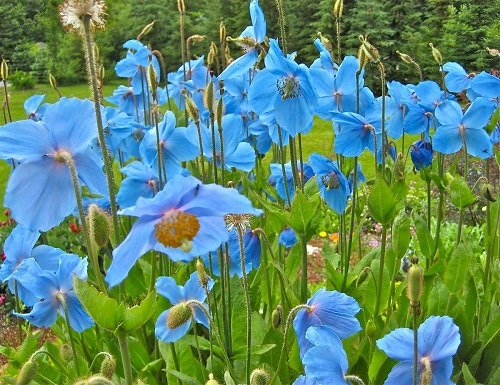
Botanical Name: Meconopsis betonicifolia
- Type: Herbaceous perennial
- Origin: Himalayan region
- Size: Up to 3 feet tall
- Light Requirements: Partial shade to full shade
- USDA Hardiness Zones: 7-8
The Himalayan Blue Poppy is a beautiful and unique plant that requires some special care, but the reward of its stunning blue flowers is well worth the effort.
Growing Tip: Himalayan Blue Poppies require cool, moist, and well-drained soil. Mulch around the base to maintain soil moisture and keep the roots cool. These plants are challenging to grow but rewarding; provide them with consistent care and protection from strong winds.
65. Blue Hydrangea Flowers
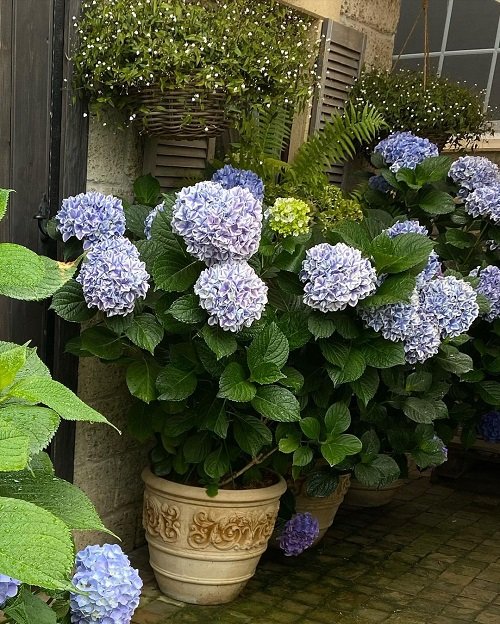
Botanical Name: Hydrangea macrophylla
- Type: Shrub
- Origin: Asia and Americas
- Size: Varies depending on the species
- Light Requirements: Partial shade to full sun
- USDA Hardiness Zones: 3-9
Hydrangeas are beautiful shrubs that produce large, showy flowers in shades of pink, blue, white, and purple. With globe-like clusters of blossoms in varying shades, blue hydrangea flowers steal these how in every garden.
Growing Tip: Blue Hydrangeas are influenced by soil pH. To keep them blue, maintain acidic soil conditions by adding aluminum sulfate. Prune hydrangeas in late winter or early spring to remove dead wood and encourage new growth and blooms.
66. Touch Me Not

Botanical Name: Impatiens
- Type: Annual
- Origin: Eurasia
- Size: Up to 3 feet tall
- Light Requirements: Partial to full shade
- USDA Hardiness Zones: 10-11
Touch Me Not, also known as Impatiens, boasts a charming display of pink and blue flowers, each resembling delicate parachutes ready to take flight. These annuals thrive in shady spots, their vibrant blooms adding a touch of whimsy to hidden garden corners.
Growing Tip: Touch Me Not, or Impatiens, are versatile annuals that adapt to partial to full shade and well-drained soil. Pay attention to the soil and keep it moist. Deadhead spent blooms regularly to promote continuous blooming.
67. Lead Plant
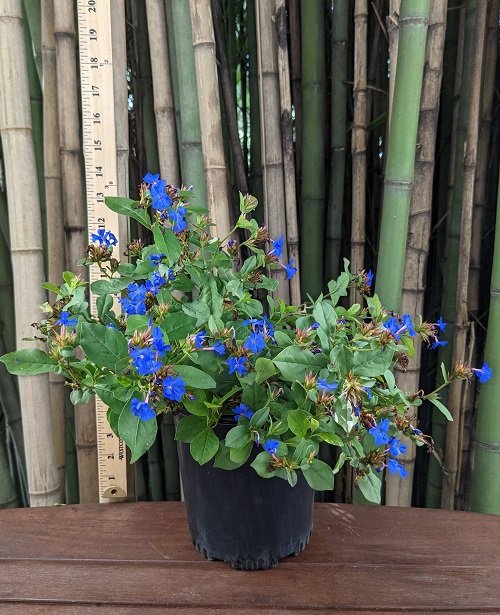
Botanical Name: Ceratostigma plubaginoides
- Type: Perennial shrub
- Origin: North America
- Size: Up to 3 feet tall
- Light Requirements: Full sun to light shade
- USDA Hardiness Zones: 5-9
Lead plant, also known as Amorpha canescens, is a drought-tolerant shrub that is native to North America and has amazing dark blue flowers that catch everyone’s eye.
Growing Tip: Lead Plants are hardy perennials that prefer bright sunlight and soil that is well-drained. They thrive in hot and dry conditions once established. Prune them back in late winter or early spring to encourage bushier growth and more flowers.
68. Lobelia
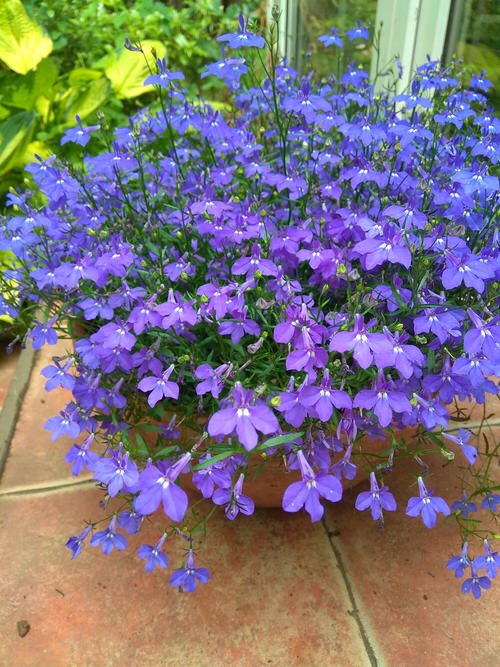
Botanical Name: Lobelia erinus
- Type: Annual
- Origin: Worldwide
- Size: Varies depending on the species
- Light Requirements: Full sun to light shade
- USDA Hardiness Zones: All Zones
Lobelia, with its tiny yet vibrant blue blossoms, adds a refreshing burst of color to your garden. These annuals are like little pieces of the sky, scattered throughout beds and borders.
Growing Tip: Lobelias are adaptable annuals that prefer full sun to partial shade and soil that stays moist. To encourage a profusion of blooms, pinch back the growing tips in early summer. Keep the soil consistently moist to ensure healthy growth.
69. Love in a Mist
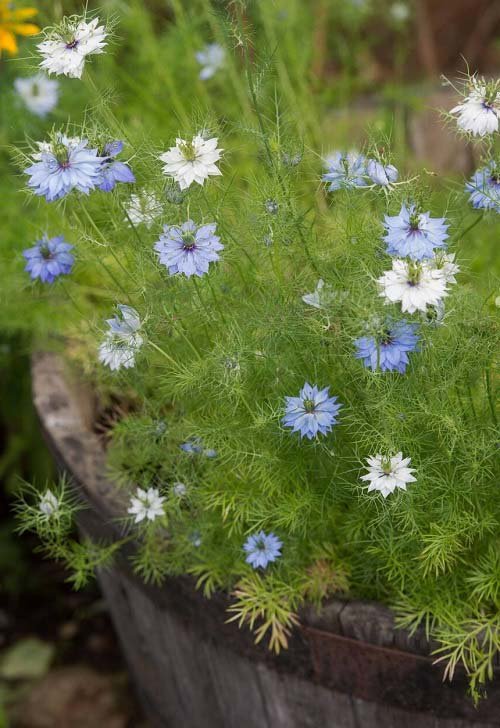
Botanical Name: Nigella damascena
- Type: Annual
- Origin: Mediterranean region
- Size: Up to 1.5 feet tall
- Light Requirements: Full sun to light shade
- USDA Hardiness Zones: 2-11
Love in a Mist blooms with intricate, fern-like foliage and captivating blue and white flowers that are like nature’s secrets hidden within a mist. This annual plant, native to the Mediterranean, enchants gardeners with its unique allure.
Growing Tip: Love in a Mist is an easy-to-grow annual that adapts to various soil types. Let some seed pods mature to self-sow for the next season. Prune back spent plants to prevent them from becoming too leggy and maintain a tidy look.
70. Lungwort
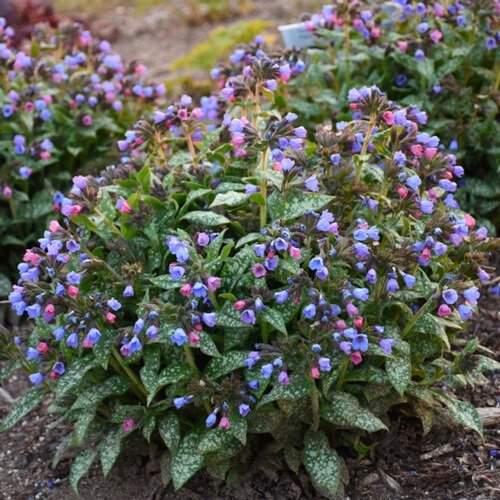
Botanical Name: Pulmonaria
- Type: Herbaceous perennial
- Origin: Europe and Asia
- Size: Up to 1.5 feet tall
- Light Requirements: Partial to full shade
- USDA Hardiness Zones: 3-8
Lungwort, known for its spotted leaves resembling lung tissue, is a hardy perennial with enchanting blue and pink flowers.
Growing Tip: Lungwort is a shade-loving perennial that prefers well-drained soil. These plants are low-maintenance and can be divided every few years to rejuvenate them. Allow the foliage to remain in the fall to protect the crown during the winter months.
71. Meadow Sage

Botanical Name: Salvia nemorosa
- Type: Perennial
- Origin: Native to Europe and Asia
- Size: Typically 1 to 2 feet tall
- Light Requirements: Full sun
- USDA Hardiness Zones: 3-8
A native to European meadows, Meadow Sage graces your garden with its spiky stalks adorned by vibrant flowers. These hardy perennials are a magnet for pollinators, inviting bees and butterflies with their nectar-filled blooms.
Growing Tip: Meadow Sage thrives in bright direct sunlight and soil full of moisture. Prune the plant after its initial bloom to encourage a second flush of flowers. These perennials are drought-tolerant once established, making them a low-maintenance choice.
72. Blue Delphinium Flowers
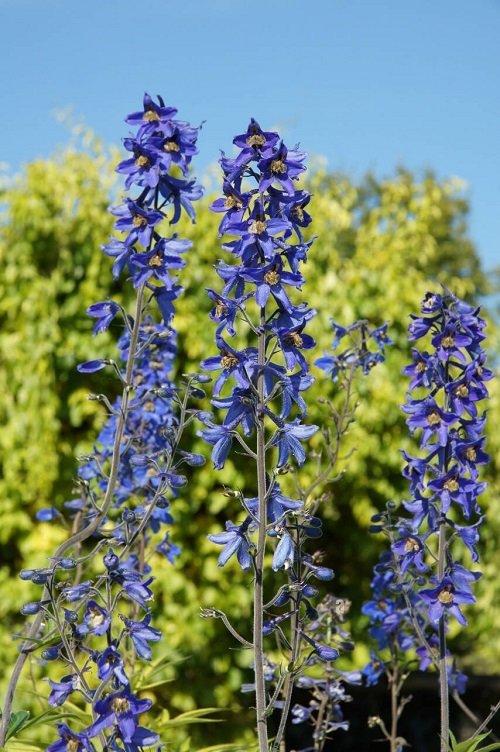
Botanical Name: Delphinium glaucum
- Type: Perennial
- Origin: Native to the western United States
- Size: Varies, can reach up to 3-4 feet tall
- Light Requirements: Full sun to part shade
- USDA Hardiness Zones: 3a-8b
Tall and stately, Blue Delphinium Flowers reach for the sky with their majestic spires of vivid blue blooms. These perennial favorites stand as sentinels in cottage gardens, offering a striking presence.
Growing Tip: Blue Delphinium Flowers are sun-loving perennials that prefer well-drained soil. Stake the tall stems to support their growth and prevent them from toppling over in the wind. Pruning spent flower spikes can encourage a second round of blooms.
73. Heavenly Blue Morning Glory
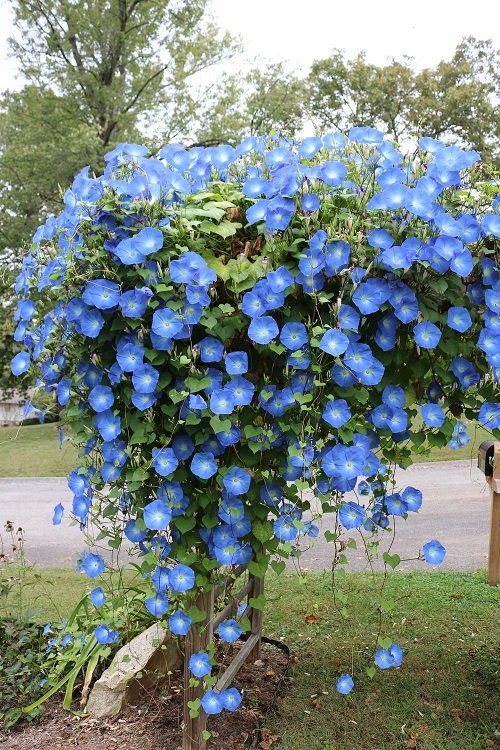
Botanical Name: Ipomoea tricolor
- Type: Annual vine
- Origin: Native to tropical regions of the Americas
- Size: Can reach up to 10 feet in length
- Light Requirements: Full sun
- USDA Hardiness Zones: 9-11
Morning glories are beautiful annual climbing vines that are easy to grow and can quickly cover trellises, fences, and walls.
Growing Tip: Heavenly Blue Morning Glories are vigorous climbers that require sturdy support structures. Plant them in full sun, where they can soak up direct rays. Soak the seeds overnight or scarify them before planting to improve germination rates.
74. Monkshood

Botanical Name: Aconitum
- Type: Herbaceous perennial
- Origin: Native to Europe and Asia
- Size: Varies by species, generally 2-4 feet tall
- Light Requirements: Part shade to full shade
- USDA Hardiness Zones: 3-7
Monkshood’s tall spires of deep blue flowers add a dramatic flair to the garden. This perennial’s unique characteristic lies in its hooded petals.
Growing Tip: Monkshood is a shade-loving perennial that prefers moist, well-drained soil. Plant it away from areas where children or pets play, as all parts of the plant are toxic. Prune back the plant after flowering to maintain a neat appearance, as it tends to get shabby if overgrown.
75. French Lavender
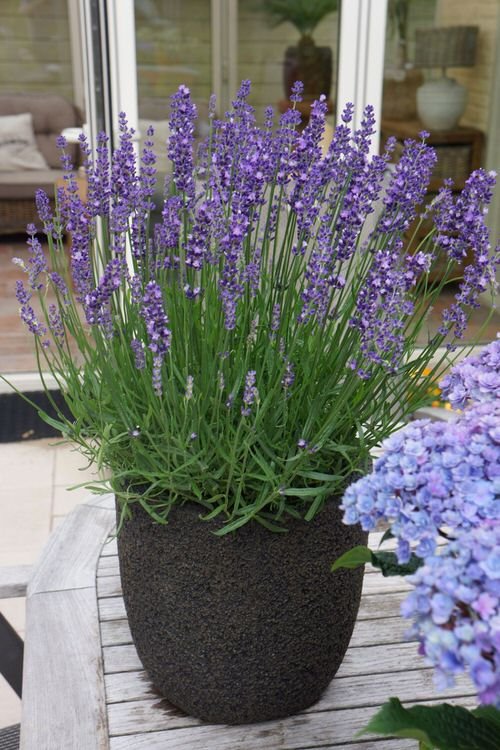
Botanical Name: Lavandula angustifolia
- Type: Shrub
- Origin: Mediterranean region
- Size: Typically 2-3 feet tall
- Light Requirements: Full sun
- USDA Hardiness Zones: 5-9
French Lavender, with its fragrant blue-purple blooms, transports you to the sunny fields of Provence. This perennial herb not only delights the senses with its aromatic foliage but also represents timeless beauty and natural charm.
Growing Tip: French Lavender flowers prefer bright sunlight and plenty of water. To encourage bushier growth and more flowers, lightly prune the plant after its initial bloom. Lavender is drought-tolerant once established but benefits from consistent watering during dry spells or hot summer months.
76. Periwinkle
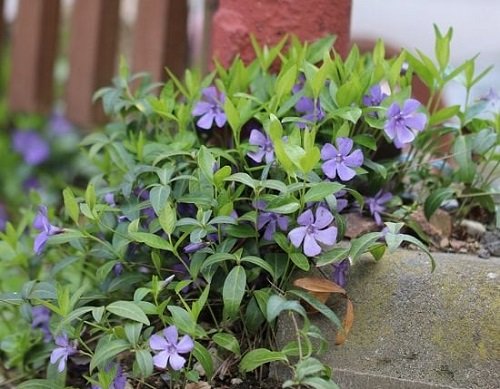
Botanical Name: Vinca minor
- Type: Ground cover perennial
- Origin: Europe and Asia
- Size: 6-8 inches tall, spreading
- Light Requirements: Part shade to full shade
- USDA Hardiness Zones: 7-9
The blue flowers of the Periwinkle carpet the ground, creating a serene, living tapestry. These small yet resilient blooms thrive in shady corners, and their vibrant hue contrasts beautifully with the dark green foliage.
Growing Tip: Periwinkle is a low-growing ground cover that adapts to various soil types. To encourage spreading, plant it close together. Periodically trim back the growth to maintain its tidy appearance and prevent it from becoming invasive.
77. Petunia
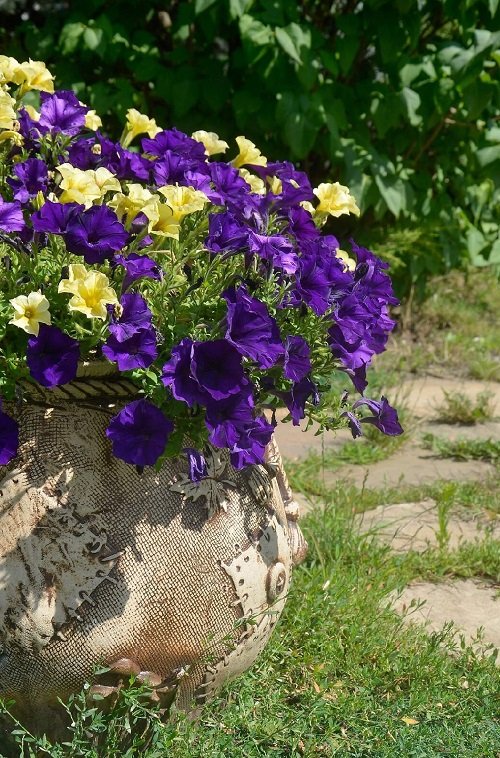
Botanical Name: Petunia x hybrida
- Type: Annual
- Origin: Garden variety
- Size: Typically 6-18 inches tall
- Light Requirements: Full sun to part shade
- USDA Hardiness Zones: 9b-11
Petunias are popular annual blue flowers known for their vibrant colors and long-lasting blooms. They are a great choice for garden borders, containers, and hanging baskets.
Growing Tip: Petunias are versatile annuals that adapt to the sun and well-drained soil. Deadhead spent flowers regularly to make sure they keep blooming. They benefit from regular fertilization during the growing season.
78. Pincushion Flower
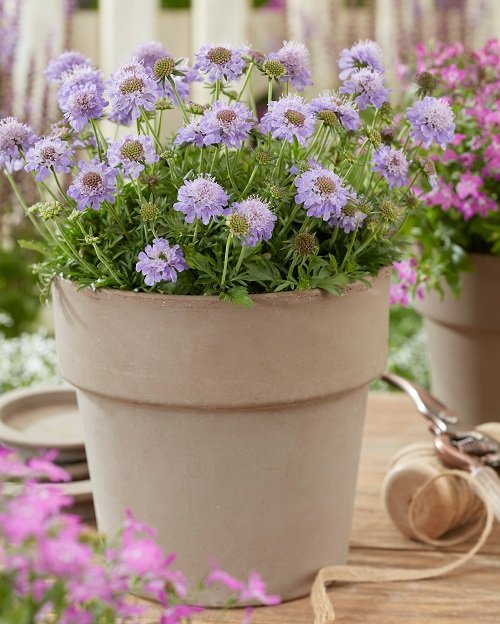
Botanical Name: Scabiosa
- Type: Perennial
- Origin: Various species, some native to Europe and Asia
- Size: Typically 1-3 feet tall
- Light Requirements: Full sun to part shade
- USDA Hardiness Zones: 3-11
The pincushion flower is a beautiful perennial plant that produces lovely, dusty blue flowers. With proper care, scabiosa can provide beautiful blooms year after year.
Growing Tip: Pincushion Flowers prefer bright rays of the sun but can also survive partial shade. Deadhead spent flowers to encourage a prolonged blooming period. Divide its clumps every few years to maintain their vigor and prevent overcrowding.
79. Plumbago
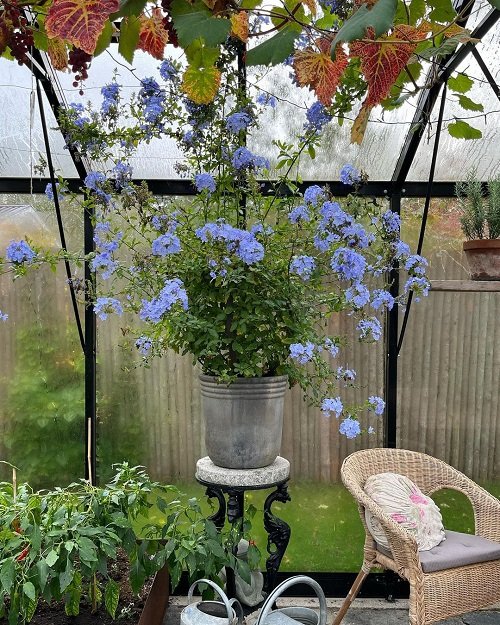
Botanical Name: Plumbago auriculata
- Type: Shrub or vine
- Origin: South Africa
- Size: Varies by species, typically 3-10 feet tall
- Light Requirements: Full sun to part shade
- USDA Hardiness Zones: 8-11
If you’re thinking of adding a splash of color to your garden or patio with flowers that are blue, then plumbago is a beautiful and easy-to-grow plant to add.
Growing Tip: Plumbago is a versatile shrub that won’t need much attention. Prune it back in late winter or early spring to shape the plant and encourage new growth. These plants are drought-tolerant once established.
80. Rose of Sharon
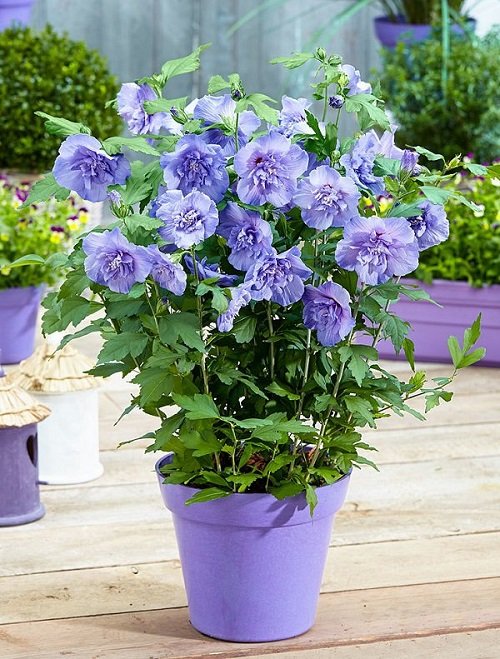
Botanical Name: Hibiscus syriacus
- Type: Shrub
- Origin: Asia
- Size: Typically 8-12 feet tall
- Light Requirements: Full sun to part shade
- USDA Hardiness Zones: 5-9
The Rose of Sharon can be grown as a specimen plant or as a hedge. With proper care, they can provide beautiful flowers and foliage year after year.
Growing Tip: Rose of Sharon is a sun-loving shrub that thrives in well-drained soil. Prune it in late winter or early spring to remove dead wood and shape the plant. These shrubs are heat-tolerant and can withstand dry spells once established.
81. Russian Sage

Botanical Name: Perovskia atriplicifolia
- Type: Perennial
- Origin: Central Asia
- Size: Typically 3-5 feet tall
- Light Requirements: Full sun
- USDA Hardiness Zones: 4-9
Russian sage is known for its aromatic, silvery-gray foliage and tall spikes of lavender and blue flowers that bloom in mid to late summer. These flowers are known for their aromatic leaves and are often used to add a touch of blue flowers aesthetic to xeriscapes.
Growing Tip: Pruning it in late winter or early spring encourages vigorous growth and prevents it from becoming too leggy. These perennials are drought-tolerant once established. Keep an eye out for aphids and mealybugs.
82. Salvia

Botanical Name: Salvia splendens
- Type: Annual or perennial, depending on species
- Origin: Various species, some native to the Americas
- Size: Varies by species, typically 1-4 feet tall
- Light Requirements: Full sun
- USDA Hardiness Zones: 9-11
Salvia, also known as sage, is known to attract pollinators, such as bees and butterflies, making them an excellent choice for a wildlife-friendly garden. The vibrant colors of these blue and purple flowers make them a beloved addition to gardens.
Growing Tip: Salvia, also known as Scarlet Sage, prefers full sun and well-drained soil. Deadhead spent flowers regularly if you want them to bloom throughout the season. These annuals are excellent for attracting pollinators to your garden.
83. Sea Holly
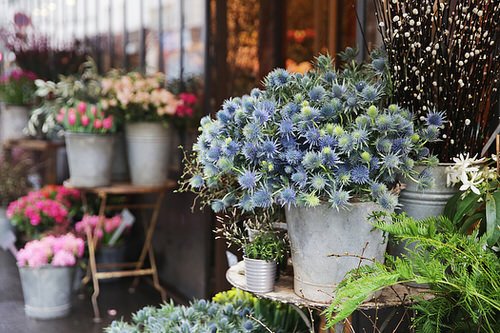
Botanical Name: Eryngium maritimum
- Type: Perennial
- Origin: Europe and Asia
- Size: Varies by species, typically 1-3 feet tall
- Light Requirements: Full sun
- USDA Hardiness Zones: 4-9
Sea Holly is a great choice to create a striking focal point or accent plant. One thing to note about Sea Holly is that it has thorny leaves and stems, so be sure to wear gloves and handle these natural blue flowers with care.
Growing Tip: Sea Holly is a salt-tolerant perennial that thrives in well-draining soil. To encourage bushier growth and more flowers, cut back the plant by one-third in early summer. These unique flowers are also great for dried flower arrangements.
84. Spiderwort
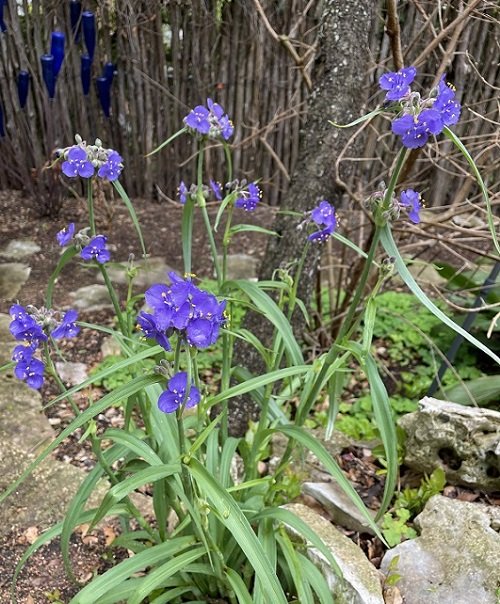
Botanical Name: Tradescantia
- Type: Perennial
- Origin: Americas
- Size: Typically 1-3 feet tall
- Light Requirements: Full sun to part shade
- USDA Hardiness Zones: 3-11
Spiderwort can be brought to your garden in the month of spring or fall. It is really easy to grow and care for. These little blue flowers are native to North and South America.
Growing Tip: Spiderworts are adaptable perennials that prefer partial to full sun and well-drained soil. You should prevent self-seeding by deadheading the spent flowers. These plants tolerate wet conditions and are suitable for rain gardens.
85. Siberian Squill
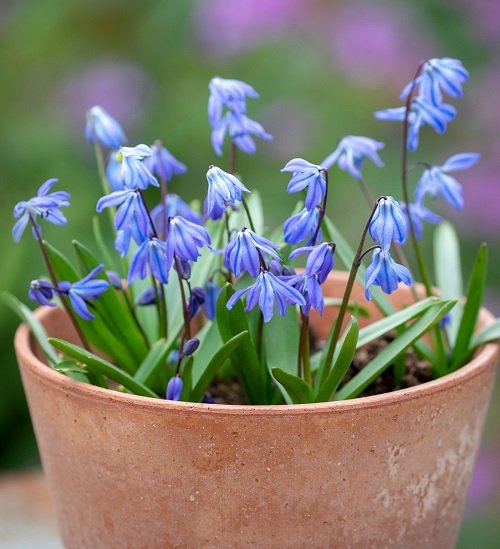
Botanical Name: Scilla sibirica
- Type: Bulbous perennial
- Origin: Siberia
- Size: Typically 4-6 inches tall
- Light Requirements: Full sun to part shade
- USDA Hardiness Zones: 2-8
Siberian Squill is a small, easy-to-grow bulbous plant that produces beautiful baby blue flowers in spring. They carpet the ground with their natural blue flowers, creating a stunning blue vista.
National Flower of Turkey and its Meaning
Growing Tip: Siberian Squill bulbs prefer well-drained soil and partial to full shade. Plant them in the fall for early spring blooms. After flowering, allow the foliage to wither naturally to nourish the bulbs for the following year.
86. Summer Snapdragon
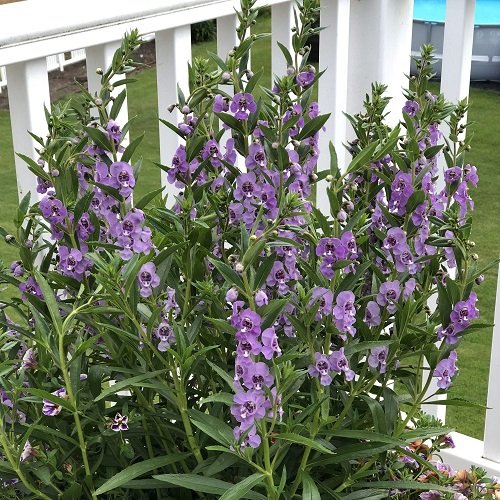
Botanical Name: Angelonia
- Type: Annual
- Origin: Native to Central and South America
- Size: Typically 1-2 feet tall
- Light Requirements: Full sun to part shade
- USDA Hardiness Zones: 9-11
These blue flowering plants thrive in the heat, making them a perfect choice for summer gardens. Their vibrant hues range from light blue to dark blue, providing a cool and inviting atmosphere to your outdoor space.
Growing Tip: Summer Snapdragons thrive in full sun and well-drained soil. These heat-tolerant annuals are excellent choices for hot summer gardens. So, if you want to add some calming flowers to the garden, you know what to choose.
87. Swan River Daisy

Botanical Name: Brachyscome iberidifolia
- Type: Annual or perennial, depending on species
- Origin: Australia
- Size: Typically 6-12 inches tall
- Light Requirements: Full sun
- USDA Hardiness Zones: 8-10
Swan River Daisy, native to Australia, boasts small blue flowers that resemble delicate petals of a swan’s plumage. With their vibrant blue and white color combination, they create a picturesque display that resembles a tranquil riverside scene.
Growing Tip: Swan River Daisies are sun-loving annual blue flowers that prefer soil that stays moist but is not waterlogged. Prune them back periodically to maintain their shape and encourage more blooms. These dainty flowers are great for containers and borders.
88. Speedwells
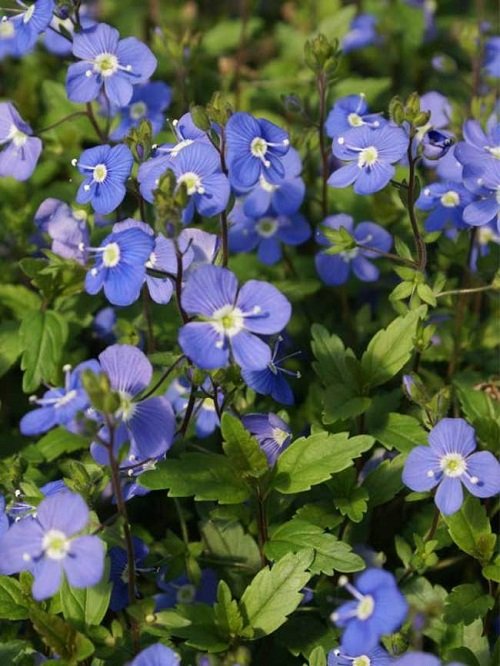
Botanical Name: Veronica
- Type: Perennial
- Origin: Various species, found in Europe, Asia, and North America
- Size: Varies by species, typically 6-36 inches tall
- Light Requirements: Full sun to part shade
- USDA Hardiness Zones: 4-11
Speedwells encompass a diverse group of flowers, including many blue perennial flowers. These blossoms, often in shades of blue and purple, are a delightful addition to any garden.
Growing Tip: Speedwells come in various species and adapt to different growing conditions. Most prefer full sun to partial shade and well-drained soil. Deadhead spent blooms if you want a prolonged blooming period and maintain a tidy appearance.
89. Veronica Georgia Blue

Botanical Name: Veronica peduncularis
- Type: Perennial groundcover
- Origin: Garden variety
- Size: Typically 6-12 inches tall
- Light Requirements: Full sun
- USDA Hardiness Zones: 4-6
Veronica Georgia Blue, a member of the Speedwells family, is known for its charming clusters of blue bonnet flowers. These blossoms, a blend of light blue and dark blue, create a soothing sight in your garden.
Growing Tip: Veronica Georgia Blue is a low-growing ground cover that thrives in direct sunlight but can also tolerate partial shade. Periodically trim back the growth to maintain a neat appearance and encourage denser coverage. These perennials are extremely tough and drought-tolerant.
90. Virginia Bluebells

Botanical Name: Mertensia virginia
- Type: Perennial
- Origin: Eastern North America
- Size: Typically 1-2 feet tall
- Light Requirements: Part shade to full shade
- USDA Hardiness Zones: 3-8
These wild flowers blue can transform the forest floor into a sea of blue and pink during the spring months. Their delicate appearance and natural charm make them a favorite among native plant enthusiasts.
Growing Tip: Plant them in the fall for a spring display. Allow the foliage to wither naturally after flowering to nourish the bulbs for the next season. These plants are prone to powdery mildew disease, so keep an eye out for the signs and take proper measures.
91. Pansy
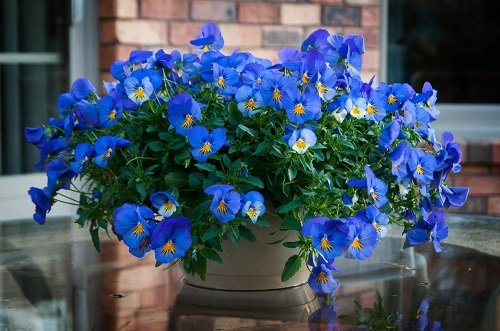
Botanical Name: Viola tricolor var. hortensis
- Type: Annual or short-lived perennial
- Origin: Garden variety
- Size: Typically 6-9 inches tall
- Light Requirements: Full sun to part shade
- USDA Hardiness Zones: 2-11
Pansies, with their cheerful faces, are true classics among blue annual flowers. They come in a wide range of colors, including shades of blue. These navy blue flowers are beloved for their cool and calming presence in gardens and containers.
Growing Tip: Pansies are cool-season annuals that prefer partial to full sun and do well in well-drained soil. These versatile plants are perfect for adding color to early spring and fall gardens. You should apply a layer of mulch to the pansies. Mulch also keeps the soil from splashing onto the foliage, reducing the risk of disease.
92. Blue Corydalis

Botanical Name: Corydalis flexuosa
- Type: Perennial
- Origin: Eastern Asia
- Size: Typically 8-12 inches tall
- Light Requirements: Part shade to full shade
- USDA Hardiness Zones: 5-7
Blue Corydalis, native to Eastern Asia, is a charming perennial known for its delicate, sky-blue flowers. These dainty blooms add a touch of elegance to shaded gardens. With their fern-like foliage and exquisite blossoms, they create a serene atmosphere.
Growing Tip: Blue Corydalis thrives in well-drained, humus-rich soil and prefers shelter from the harsh afternoon sun. Keep the soil consistently moist, especially during dry spells, to encourage continuous flowering. Pruning faded flower stalks can prolong the blooming season.
93. Blue Toadflax
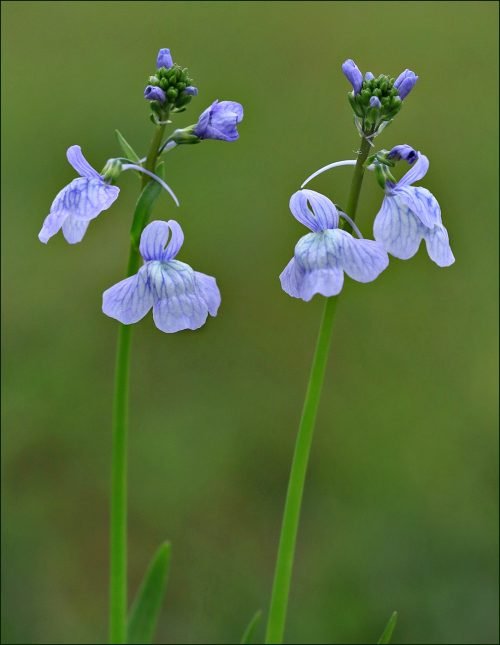
Botanical Name: Linaria canadensis
- Type: Perennial
- Origin: North America
- Size: Typically 12-18 inches tall
- Light Requirements: Full sun to part shade
- USDA Hardiness Zones: 4-9
Blue Toadflax, a native North American perennial, bears clusters of small, blue-purple flowers. These wildflowers are known for their resilience and adaptability, making them a valuable addition to naturalized landscapes and meadows.
Growing Tip: Blue Toadflax thrives in various soil types as long as they are well-draining. They prefer full sun but can tolerate some shade. Deadheading spent flowers can promote additional flowering, and their self-seeding nature ensures a consistent display year after year.
94. Blue Porterweed
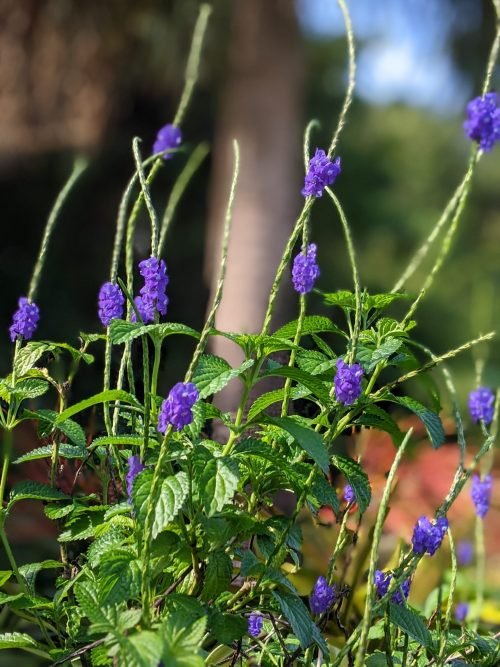
Botanical Name: Stachytarpheta cayennensis
- Type: Perennial
- Origin: South America
- Size: Typically 2-3 feet tall
- Light Requirements: Full sun
- USDA Hardiness Zones: 9-11
Blue Porterweed, native to South America, features striking indigo-blue spikes of flowers. These tall, slender blooms attract pollinators and add a tropical flair to gardens in warm climates.
Growing Tip: Plant Blue Porterweed in a spot with direct sunlight. Regular deadheading encourages continuous flowering and prevents self-seeding. In regions with cooler winters, it may be grown as an annual. Prune the plant to maintain its shape and size.
95. Blue Thimble Flower
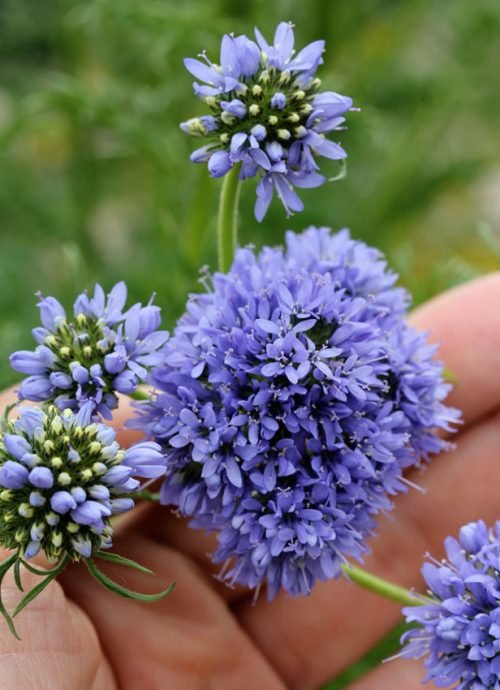
Botanical Name: Globularia nudicaulis
- Type: Perennial
- Origin: Europe
- Size: Typically 4-8 inches tall
- Light Requirements: Full sun to part shade
- USDA Hardiness Zones: 4-8
Blue Thimble Flower, native to Europe, showcases clusters of tiny blue flowers. Its low-growing habit and rosette-like foliage make it an excellent choice for rock gardens and alpine plantings.
Growing Tip: Plant Blue Thimble Flower in well-drained soil and provide adequate sunlight. These hardy perennials require minimal maintenance but benefit from occasional deadheading to encourage repeat blooming.
96. Blue Witch Nightshade
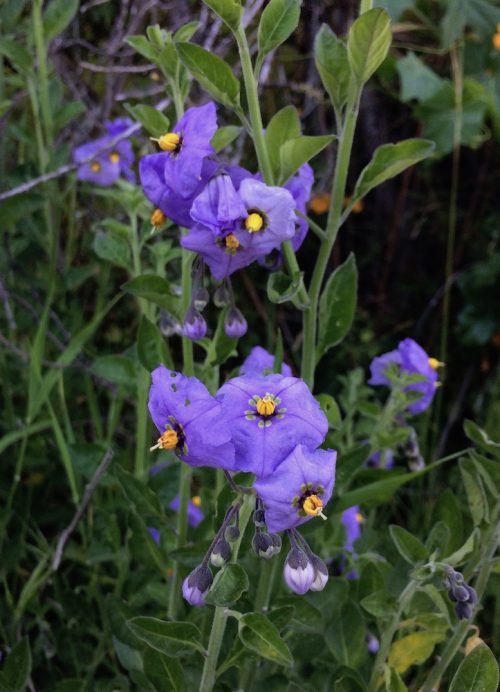
Botanical Name: Solanum umbelliferum
- Type: Perennial
- Origin: California, USA
- Size: Typically 1-3 feet tall
- Light Requirements: Full sun
- USDA Hardiness Zones: 7-10
Blue Witch Nightshade, native to California, boasts clusters of deep-blue to purple flowers. This drought-tolerant perennial is well-suited for xeriscaping and adds a touch of vibrant color to dry, sunny landscapes.
Growing Tip: Plant Blue Witch Nightshade in well-draining soil and provide plenty of sunlight. Water sparingly, as these plants are adapted to dry conditions. Prune them to maintain shape and remove spent blossoms to encourage new growth.
97. Blue Mistflower
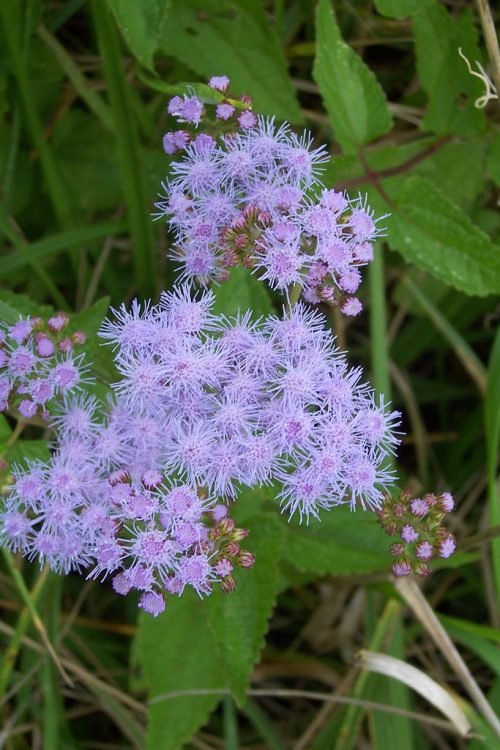
Botanical Name: Conoclinium coelestinum
- Type: Perennial
- Origin: Eastern North America
- Size: Typically 1-3 feet tall
- Light Requirements: Full sun to part shade
- USDA Hardiness Zones: 5-9
Blue Mistflower, native to Eastern North America, showcases fluffy clusters of powder-blue flowers. This perennial is highly attractive to butterflies and pollinators, making it a valuable addition to wildlife-friendly gardens.
Growing Tip: Plant Blue Mistflower in well-draining soil and provide moderate sunlight. These perennials appreciate consistent moisture but can tolerate brief periods of drought. Pruning in late spring can help control their growth and shape.
98. Blue Wood Aster
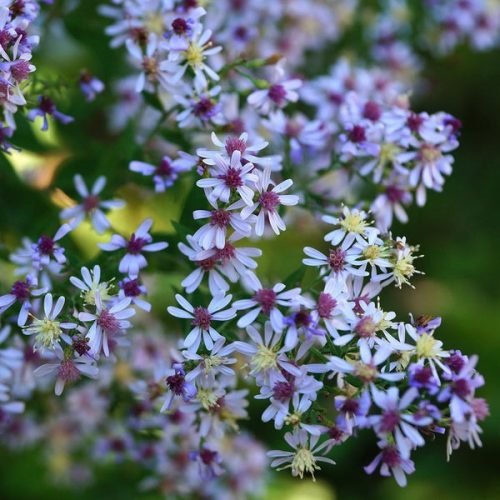
Botanical Name: Symphyotrichum cordifolium
- Type: Perennial
- Origin: Eastern North America
- Size: Typically 1-3 feet tall
- Light Requirements: Part shade to full shade
- USDA Hardiness Zones: 3-8
Blue Wood Aster, native to Eastern North America, produces clusters of dainty, sky-blue blossoms in late summer to early fall. Its heart-shaped leaves and delicate flowers add a touch of elegance to shaded woodland gardens.
Growing Tip: Plant Blue Wood Aster in well-drained, humus-rich soil in a shaded location. Provide consistent moisture, especially during dry spells, to promote healthy growth and flowering.
99. Blue Puya
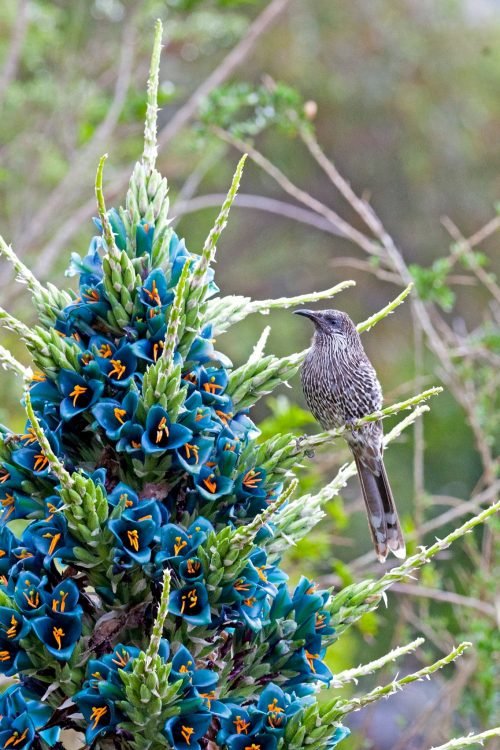
Botanical Name: Puya coerulea
- Type: Perennial
- Origin: South America
- Size: Typically 3-5 feet tall
- Light Requirements: Full sun
- USDA Hardiness Zones: 9-11
Blue Puya, hailing from South America, is a striking perennial known for its dramatic blue-green foliage and tall, spiky flower spikes. Its unique appearance makes it a standout in arid and xeriscape gardens.
Growing Tip: Plant Blue Puya in well-draining soil and ensure it receives ample sunlight. While it’s drought-tolerant, occasional deep watering during dry spells can promote healthy growth. Be cautious around its spiky leaves, as they can be sharp.
100. Blue Stickseed
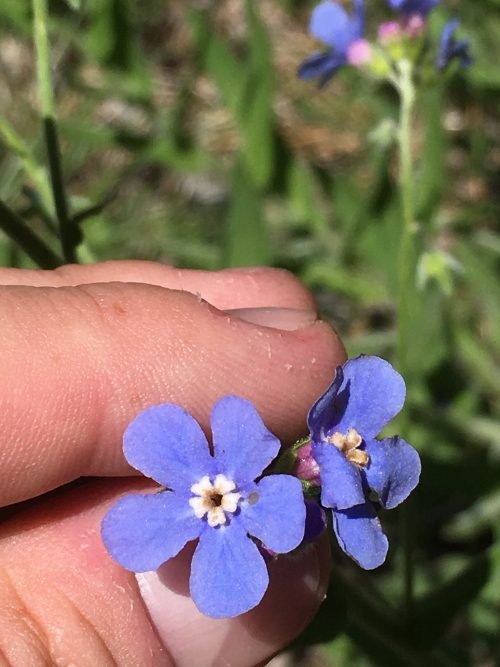
Botanical Name: Hackelia micrantha
- Type: Annual
- Origin: Western North America
- Size: Typically 1-2 feet tall
- Light Requirements: Full sun to part shade
- USDA Hardiness Zones: 4-9
Blue Stickseed is a charming annual native to Western North America. It boasts clusters of small, azure-blue flowers that resemble forget-me-nots, adding a touch of delicacy to gardens and wildflower meadows.
Growing Tip: Plant Blue Stickseed in well-draining soil and provide it with partial sunlight. Regular watering helps maintain moisture levels in the soil, ensuring a vibrant display of blue blooms throughout the growing season.
101. Blue Dicks
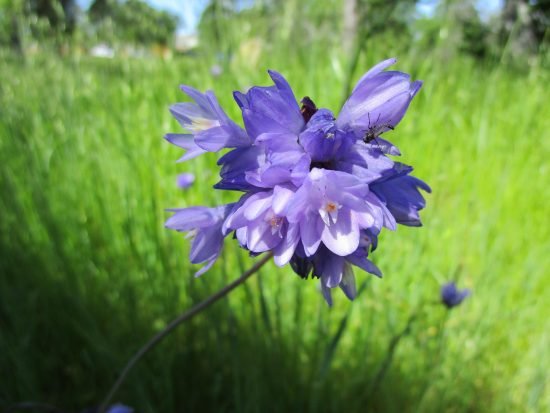
Botanical Name: Dichelostemma capitatum
- Type: Perennial
- Origin: Western North America
- Size: Typically 1-2 feet tall
- Light Requirements: Full sun
- USDA Hardiness Zones: 6-9
Blue Dicks, a native perennial of Western North America, presents striking blue, tubular flowers in late spring. Its slender stems and vibrant blossoms make it a favorite for naturalizing in meadows and cottage gardens.
Growing Tip: Plant Blue Dicks in well-drained soil under full sun. Allow the soil to dry between waterings to prevent rot. Once established, these perennials require minimal care and will grace your garden with their blue hues year after year.
102. Blue Jacaranda Tree
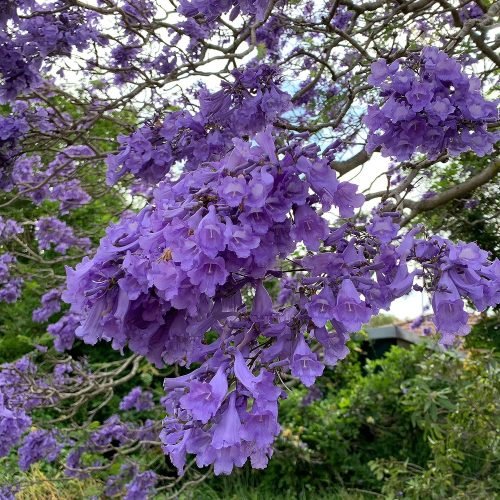
Botanical Name: Jacaranda mimosifolia
- Type: Deciduous Tree
- Origin: South America
- Size: Typically 20-30 feet tall
- Light Requirements: Full sun
- USDA Hardiness Zones: 9-11
The Blue Jacaranda Tree is an enchanting deciduous tree native to South America. During its flowering season, it produces a stunning display of violet-blue, trumpet-shaped blossoms that carpet the ground beneath, creating a mesmerizing sight.
Growing Tip: Plant Blue Jacaranda Trees in well-draining soil and provide them with plenty of sunlight. These trees thrive in warm climates and can tolerate periods of drought once established. Prune them sparingly to maintain their natural, graceful form.
Note: These care guidelines should help you grow these blue flowers successfully in your garden. Keep in mind that local conditions and climate may affect specific care requirements, so always observe your plants and adjust care practices accordingly. Happy gardening!


